23. Hidden Piece Puzzles Part 2 – Assembly
This Part includes my experiences assembling Home in the Desert 1 and Grow Old Together, and artist’s profiles (about 4000 words; 48 pictures)
For my detailed review of these puzzles and the Hidden Piece Puzzles company in general, see Part 1.
Home in the Desert 1
Artist – Shachi Kale
Made by Hidden Piece Puzzles (Arizona) designer Robert Bermudez
laser-cut 5+ mm maple-veneered poplar
531 pieces 17½” x 14½” (37cm x 44.5cm) average 3.0 cm²/pc
The artist and her art
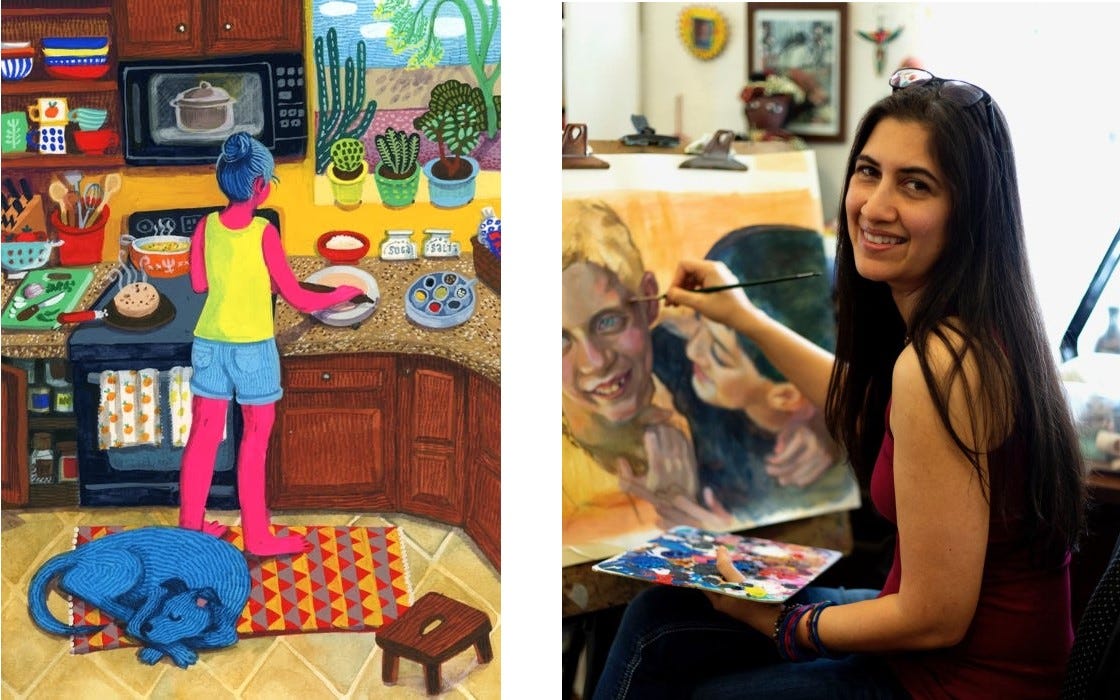
Shachi Kale is an artist, portraitist and illustrator, but her preferred description of her work is that she is a “visual storyteller.” Shachi grew up in Mumbai, India where she received training in graphic design and began a career in advertising. She moved to Arizona with her husband 22 years ago. Here is her website which includes galleries showing her diverse styles of paintings.
There is considerable insight into Sachi’s personality in her short-lived blog. Separately from that, in this interview she acknowledges that a lot of the subjects of her paintings are autobiographical and that her early upbringing influences how she depicts her current surroundings:
Just living in India meant being surrounded by color, patterns, and story. All around me were textiles with patterns, bright colors in jewelry and lush plants. All those elements have subconsciously influenced my art. Growing up with the rich tapestry of stories from the Ramayan, Mahabharat, folk tales as well stories of mythology and magic along with a lot of classic children’s literature has crept into my art … and made me look at my own life and the lives of others as stories that are unfolding in front of my eyes.
According to this online article about her from Create! Magazine Sachi found the move to Arizona to be “both easy and difficult.” She has come to love living and raising two boys there, but her art is also a way for her to grapple with her feelings of change, loss and regrowth. It is her love of her hew habitat that came across to me while I assembled this puzzle.
The painting that provides the image for the puzzle was featured in a themed solo show called My Home in the Desert that she held in Phoenix’s Practical Art Gallery in June 2020. Here are the other three paintings in the Home in the Desert series from that show:
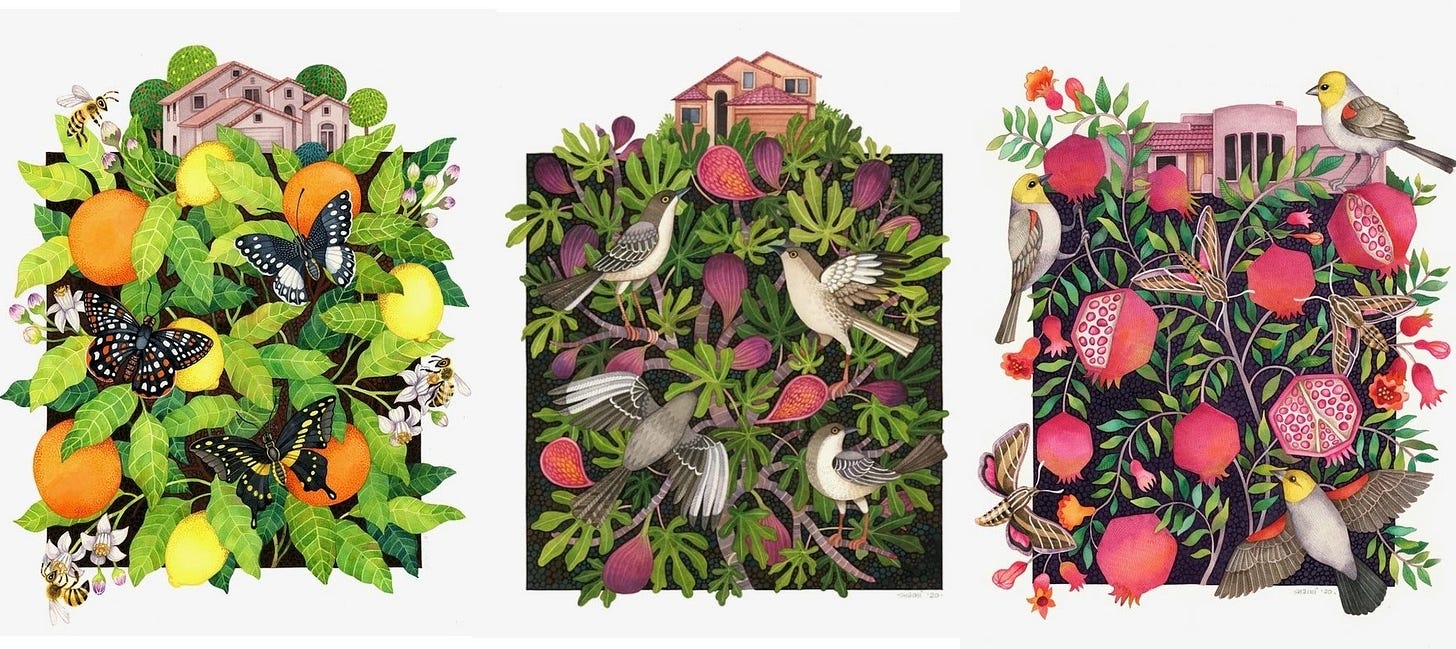
The notes for that show say:
She looks at the idea of home from the perspective of humans and the animals, plants and creatures that inhabit the desert. The unique beauty of the dry thorny desert plants and sand colored animals, juxtaposed against the bright flashes of color of the hummingbird and the juicy brightness of the citrus plants shows that it is a land of contrast and surprise. She takes inspiration from her urban landscape and how humans and nature have found a way to co-exist in this harsh but unique environment.
That reference to “her urban landscape” caught my attention. Also, studying the architecture of the buildings in the four paintings I cannot reconcile them with being depictions of the same hacienda. While I was assembling the puzzle I had been taking the title literally and thought of it as being a painting of Shachi’s actual home.
I should have known better. Depiction of a quaint, nostalgic and rather old-fashioned view of the one’s surroundings is not only common in folk art, it is a characteristic of that style of illustration. Many of Shachi’s paintings have a fantasy element to them. I now think that the adobe houses that we see in her paintings could be real places, or idealized desert houses, or possibly her dreams of a home in the desert.
I hope that Shachi doesn’t mind me calling her style of painting “folk art.” In my mind that is a high compliment, but it is an artistic style that doesn’t get much respect from the fine art community. They seem to rate folk artists even below “illustrators” in their snobbish pecking order, and they use the terms “primitive art” or “naïve art” when referring to it.
I hate those dismissive terms. They suggest that the apparent simplicity of the artists’ renderings is due to an inability to produce more sophisticated renderings of their subject matter. I believe that is far from the case. In general, the fact that folk artists portray scenes and objects with simplicity should not overshadow their genius at imbuing their works with unparalleled emotional strength.
The following three works depict rich contrasting emotions. They were painted by a well-known painter who came from an artistic family. He had little formal art training himself and he rejected the conventions of the fine art world. But in my mind these works have all of the characteristics of being “folk art”:
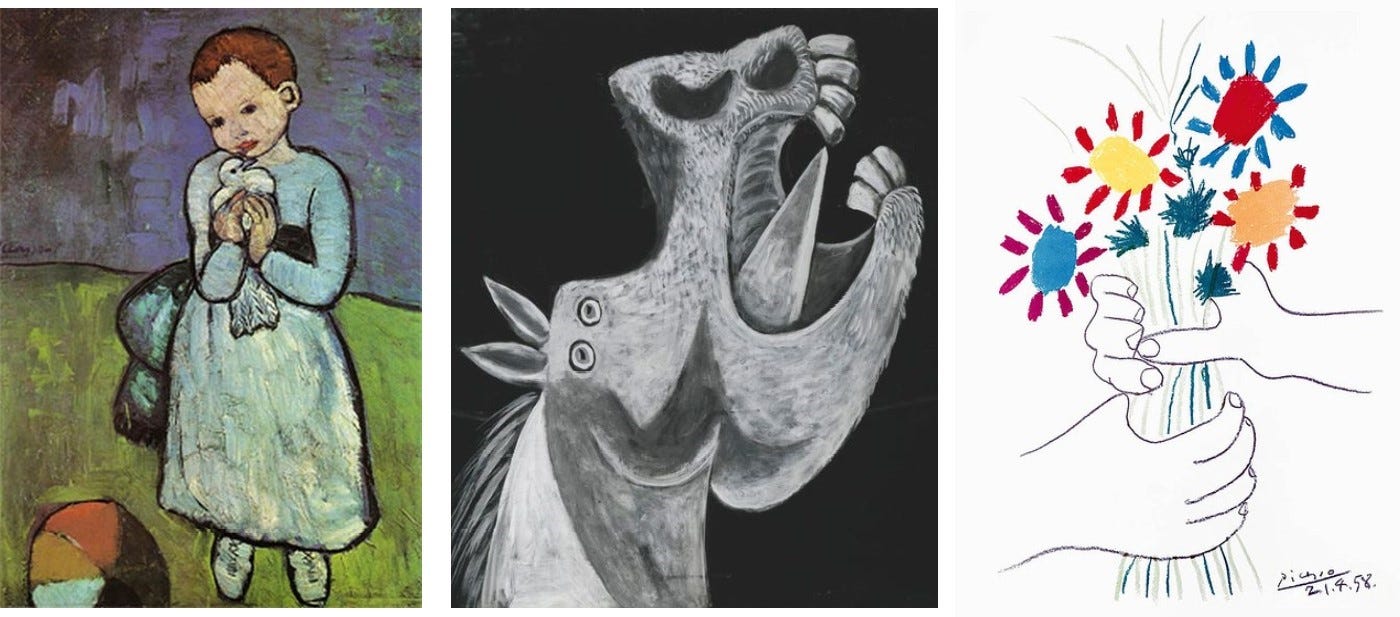
Assembly
At my request Robert had covered up the pictures on the covers and sides of both boxes before he sent the puzzles to me, but I had seen this image when I was studying the website deciding which puzzle to buy. All I recalled about this one was that it was in portrait orientation with partial shaping on the sides of the puzzle, and that there was an adobe house in the middle distance with large brightly-coloured desert plants in the foreground.
The puzzle has 511 pieces so I knew that they would not all fit onto one puzzle-board. After flipping and doing an initial sort I spent more time colour-sorting and organizing the pieces than usual. Unfortunately, I forgot to take a photo of the initial flipping and sorting before the re-sorting.
Although I knew that there was some shaping on the sides of the puzzle as if the hardy desert plants are bursting out of the frame out of habit I organized the apparent edge pieces along the bottom of the main board anyway. It was noticeable that some of the edge pieces were all the same shade of blue, and unlike the other coloured pieces they didn’t have much pattern on them. Sky?
Besides the figural pieces there were several sprawly ones, like large spirals that looked like they could be combined together quickly. I put those on the right-hand side of the main board (face down to emphasize their shapes.) I had begun colour-sorting while I was doing the initial flipping. There seemed to be a lot of green pieces so I put those on the left-hand side of the board.
Other than the sky that was likely to be blue I had no idea where the various colours would appear in the puzzle’s artwork. In my re-sorting I grouped them by colour but there wasn’t too much logic in which colours were on the main board and which were on the small one. As it turns out, I got them backwards. My very limited working space was in the centre of the main board, but the colours that I ended up assembling first were all on the side-board. So I ended up having to do a lot of moving of loose pieces around from one board to the other.
After all that sorting my initial assembly went so smoothly that I forgot to take an early photo. Large areas of blue, magenta, pink, brown and grey/white came together easily, as did some clusters with distinctive stripes.
I continued to build clusters of pieces that had similar colours and textures. The overall impression is somewhat like a crazy-quilt made from different patterned fabrics. The puzzle made me think of the Unidragon Fiery Fox puzzle (reviewed here) with its areas of colour and pattern.

A white patch made up of several pieces had green agave leaf-spikes thrusting up into it, and the white expanded upwards to include pink pieces with straight lines separating the colours and shades. I recognized that this must be the adobe building that I had remembered from the image. The golden tree is mostly comprised of pieces from a sun-shaped multi-piece whimsy.
I continued to work mostly on building out the island clusters of distinctive colours and patterns. The golden tree with tweezers pointing to it in the following photo continued to bother me. I realized that pieces of the sun-shaped whimsy were interchangeable with each other (that sneaky Robert!) and I had some of them misplaced.
I used the tweezers to remove the misplaced pieces and experimented to figure out where they belonged. This is much better:
Completing the sky and connecting the building to the golden tree gave me a feeling that the image was finally beginning to take shape, . . .
. . . as did piecing together the agave plants in front of the hacienda and being able connect the purple prickly-pear to the upper part of the puzzle. This finally gave the image the portrait orientation that I had been expecting.
Are you wondering why it took me so long to complete that top edge? These are examples of what Robert thinks edge pieces should look like:
Progress began going rather slowly now. Part of that was because I sometimes just sat back and enjoyed the view. But mostly it was because assembly was now getting more challenging. The remaining loose pieces had to be added one-by-one to the edges of existing built-up areas rather than assembled as their own islands.
But at least I had working room now and I was able to move all of the pieces to the main puzzle-board. I put the purple prickly-pear coloured pieces on the right-hand side of the board and the brown and light-blue saguaro pieces on the left. The shaped edges on the side of the puzzle definitely added to the challenge
I can’t put my finger on why, but Robert’s cutting design in this part of the puzzle seemed to be particularly tricky. Throughout the puzzle I had been mostly using colours and the distinctive shapes of whimsy silhouettes to create island-clusters. Now making progress depended upon trying to fill in gaps with shape-matching. I was constantly finding that the right piece was a different shape than what I was expecting. Maybe I was having a particularly brain-fuzzy day, but I prefer to credit my slow progress to Robert’s design skills.
Finally it did all come together:
Grow Old Together
Artist – Gwen van Knippenberg
Designer – Robert Bermudez
laser-cut 5 mm maple-veneered poplar
505 pieces 16¼” x 1” (37cm x 44.5cm) average 2.8 cm²/pc
The artist and her art

Gwen van Knippenberg now lives with her family in Amstelveen, which is a suburb of Amsterdam in the flat part of the Netherlands, but she grew up near Nijmegen in the hilly and forested province of Gelderland near the border with Germany.
As a young adult her intention was to become a lawyer and to achieve that goal she got a degree from Utrecht University. But she found the legal profession didn’t appeal to her and didn’t return to it after giving birth to her first child. Instead, Gwen became a full-time home-maker, raising four children. As they grew older she began turning her life-long enjoyment of making art and crafts into a new full-time job. She currently sells cards, postcards and prints with her images via Etsy, but she plans to launch her own website store this summer.
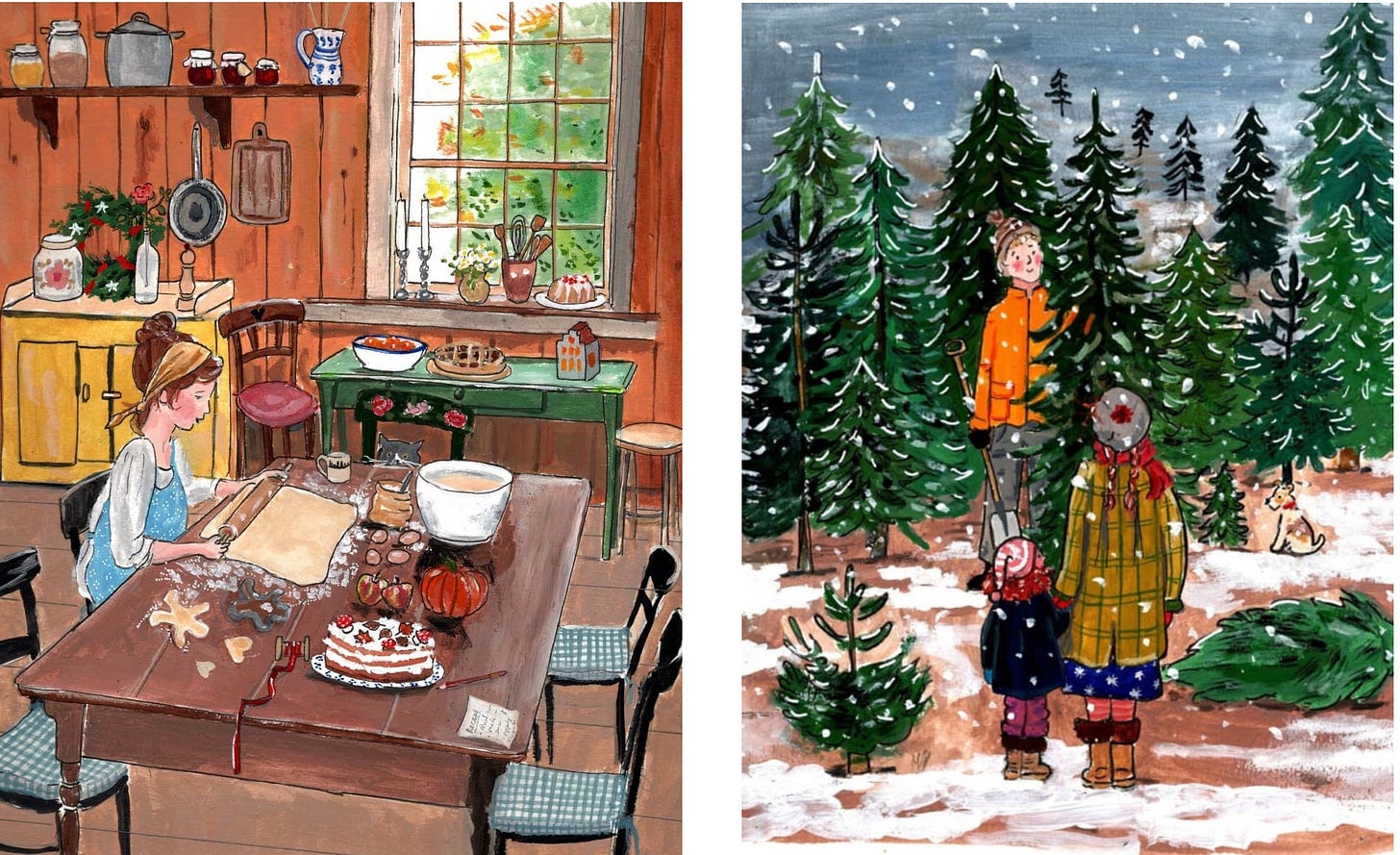
While I was assembling this puzzle and seeing her other paintings online I began to imagine an autobiographical story behind this and her other equally endearing paintings. You can see more of her paintings for yourself here, here and here. I knew that my mental story-telling was at best only partly-true, but I was able to find only a few scraps of information about Gwen and her artwork online. That didn’t seem enough for this essay. With encouragement from Robert and Becky I contacted the artist by e-mail a few days ago. Here is her story in her own words (lightly edited):
Thank you for your really kind review of the Grow Old Together puzzle and my image. Rebecca and Robert sent me the puzzle and I loved assembling it. Such beautiful quality and the cutting of the puzzle pieces is amazing. Altogether, back and front, the puzzle tells a story.
I made the small painting a few years ago after I saw a picture of an old couple somewhere and it moved me. It inspired me to draw a sweet old couple for which I used my own imagination. Sometimes I draw real people from my life, but most of the time my paintings are a mix from images from my memory, fantasy and all things I see around me. I also get inspiration from our travels to Great-Britain every year and the years I lived in New York.
I am completely self-taught, but have been creative my whole life. My paintings probably tell a lot about me but it is not my intention to make autobiographical work. I try to make work that makes myself and other people happy, makes them smile, gives them comfort maybe, makes them feel good.
The place in the Grow Old painting is completely from my fantasy. The long road symbolizes their life together, and they are still enjoying life and walking into a bright future together. When I painted it I wasn’t thinking about this, I just paint on my intuition, but I guess this is what I wanted to express.
You are right that I often paint rural settings and little red houses! Not really Dutch, but that is what I love so much about drawing and painting: that I can make my own perfect world.
Assembly
My memory of this puzzle’s image was that it was a folk-art style of painting depicting an elderly couple walking together along a road. They are walking away from the point-of-view so you can’t see their faces, but their body language conveys affection. As I explained in the review, I had immediately fallen in love with the image and decided to buy it even without paying much attention to its cutting pattern.
From Home in the Desert 1 I had learned that this size of puzzle would fill up both of my puzzle-boards, so to give me more working room I also used the top of a candy box to spread out its 531 pieces. As I was flipping them I found that there were a lot of green ones and beige ones. I put them on the main board along with the potential edge pieces.
I put the pieces that were predominantly other colours on the small board along with large spirals and other sprawly pieces of a type that in Home in the Desert 1 had been among the earliest ones I was able to combine together. At first I put the figural pieces on the main board too but as it got too crowded I moved them onto the small board too, and moved the miscellaneous coloured pieces to the candy box.
As you can see, there aren’t too many pieces that were not predominantly green, beige or black. I began to suspect that this puzzle would be more challenging than the other one had been.
In retrospect I now know that it would have been better to put those relatively few pieces on the main board where their consolidation would have grown my working space, and that I should have put the many predominantly green pieces on the side storage board since assembly often involves doing the most common colour last. The fact that so many of the potential edge pieces were green should have hinted that would be the case with this puzzle too.
That proves what a slow learner I am because it is the same mistake I made when sorting pieces for Home in the Desert 1! I had not realized that there would be so many green pieces when I began my flipping and sorting. In the future, with large puzzles like this I think that (if I remember this lesson!) I will begin with much more flipping to determine what the most common colours will be before I start sorting, and then put those and the edge pieces on the side-board.
As it was, a few of the apparent edge pieces were a particular shade of light green and I began by assembling a little strip of them, but that involved finding two of the pieces among the presumed non-edges:
It was quickly obvious that while short bits of edge could be assembled this way it would be slow and tedious looking for the non-apparent edge pieces ones amongst so many green ones. After a few more tentative starts by assembling around the distinctive outlines of figural pieces and consolidating the sprawly pieces I decided to begin by making island clusters from the relatively few distinctively coloured ones.
The beige colour in the bicycle-built-for-two in the next photo is almost exactly the same shade and tone as the maple veneer on the back of the puzzle. (The apparent white colour in the photo is due to reflection from my bright task-light.) Just like the grain in maple wood there are slightly different shades of beige in the artist’s brushwork. I found that I had to frequently turn loose beige pieces over to confirm that I had them right-side up. The main clues were the differences in texture between the two sides, and that back sides often had mild scorching near the cut-lines.
Once the couple were together the puzzle began to have a personality. I find that I like books, movies and TV shows best if I like the characters and care what happens to them. I think I respond to puzzles that way too. Even though I can’t see the faces of this elderly couple, a sense of their personality strongly came through and I began to feel that I liked them. Those feelings of affection grew through the rest of the assembly.
I was very pleased when I was able to connect the red house with the buildings across the road, and then again when I was able to use the smoke from its chimney to reach the top edge and then add my earlier light-green edge sub-assembly strip to it. Next I worked on putting some black pieces together on my side-board and moved them to the working space on the main puzzle-board . . .
. . . and figured out how to put those black pieces together:
I figured that the road the people were on must connect with the road between the buildings but I didn’t have a connection between them yet, or enough working space on my space on my puzzle-board to put them there. Then I realized that what I thought of as a black stream must connect to the black ditch next to the road between the buildings. So I shuffled around loose pieces to make more workspace room.
This next photo has had only a couple of loose pieces added after the previous photo:
The burst of progress continued . . .
. . . until the completion of Maple Road:
I really enjoyed the way that the image developed as I assembled this puzzle by starting from the focus point and working outwards from there. I think that in the future I will try to remember to begin by making island clusters if I think that I could build the image’s focal point from such a large jumble of loose pieces. In fact, I think I’ll do it that that way even when assembly starting with the outside edge pieces seems possible.
Assembling frame-first is probably the more efficient way to build many puzzles, but pleasure of assembly is much more important for me than efficiency, and this approach seems more enjoyable. I might even glance at the image of some puzzles beforehand (Gasp!) to determine if the centre of focus has colours, textures or patterns that make it seem a feasible place to begin.
At his point I had made enough progress to consolidate all of the pieces onto the main puzzle-board. Nothing left now but lots of green. Lots of Green! Fortunately, green is a very soothing colour.
As you would expect, my progress slowed down when all of the pieces I was seeking could hide amongst their green buddies. But there were different shades and tones of green. I focused on the top part of the puzzle where it tended to be bright light-green, and the area adjacent to the ditch where there was darker green.
The two small clusters of edge pieces on the left of the puzzle each had a rabbit, and from both an image-composition and bunny-behavioural perspective I figured that they should be near each other.
Assembly was slow-going at this stage, but inspired by these bunnies and ducklings I was nibbling away at it. There were many dabs of bright colour in the open meadow depicting wildflowers, and they tended to be near other dabs of similar colour, size and shape.
At this point I had to take a break from assembly for a few days to focus on other tasks. When I came back I suddenly made quick progress, mostly by emplacing the two larger clusters that were shown in the above photo. Other than putting in those figural-based clusters this next photo only has a couple of pieces added:
But then it was back to slow progress. By the way, whenever I say “slow progress” here and in other puzzle walk-throughs that is a statement of fact, not a complaint. Slow progress just means that there is more time between puzzling’s little victories, and that makes each one of them seem like a big accomplishment. If my progress ever gets slowed so much that it brings up feelings of frustration or being stuck, or even close to that, you can be sure I will let you know about it! I am quite capable of whining if the mood strikes me.
This next photo celebrates both putting in the last two figural-based island assemblies and completing the edge:
Now all of the pieces seemed to be the same shades of green, approximately the same size and baroque shape, and every one of them would go into the puzzle next to pieces that are already in place. That last factor should have made it easy, but just like in Home in the Desert 1, shape-matching near end was the slowest-going stage of the assembly.
Eventually I got down to just three pieces . . .
. . . and they found their places pretty quickly. What a beautiful puzzle!
The following photo of the big wedding multi-piece whimsy is from Hidden Piece Puzzles’ website so I guess it doesn’t really need to be below the Spoiler Alert. But I decided to buy this puzzle because I fell in love with its image and hadn’t looked carefully at the pictures of the whimsies then, nor at the picture of it on the back of the box.
As I was assembling in its vicinity I knew that a large multi-piece whimsy was developing. I could see its bits and pieces but I couldn’t really appreciate it in the context of the distractions from the image. When I turned the completed puzzle over its sheer beauty and the appropriateness of its location came as a big surprise.
.





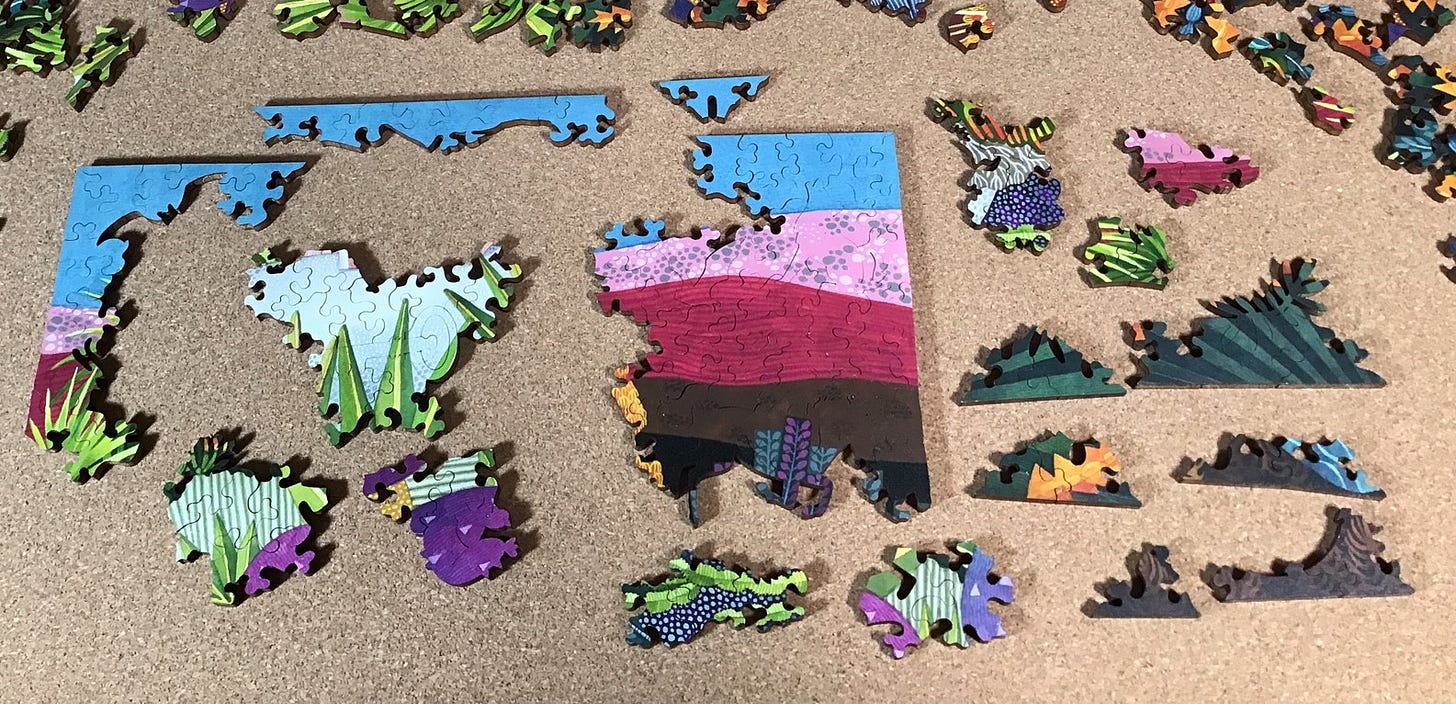

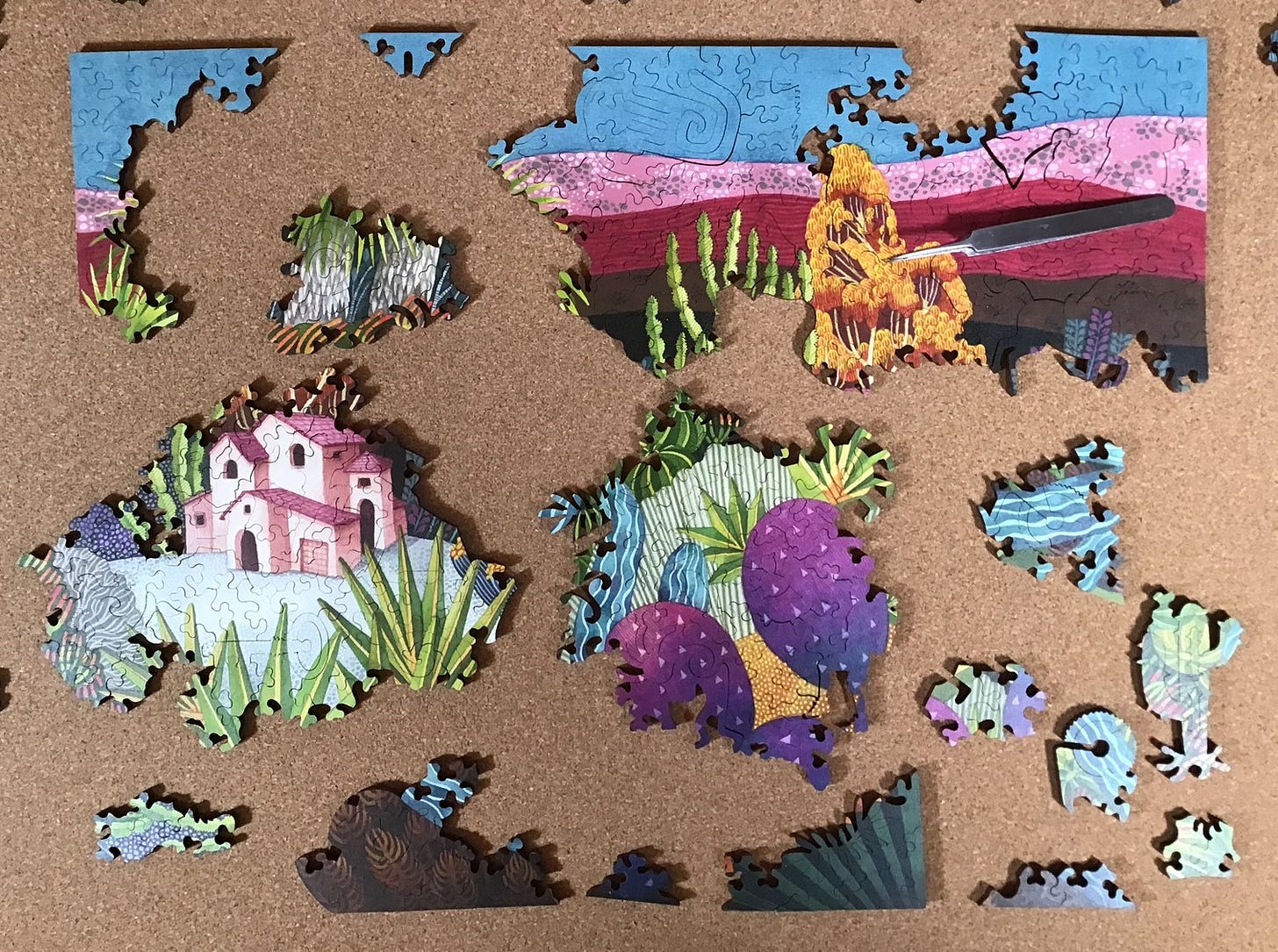
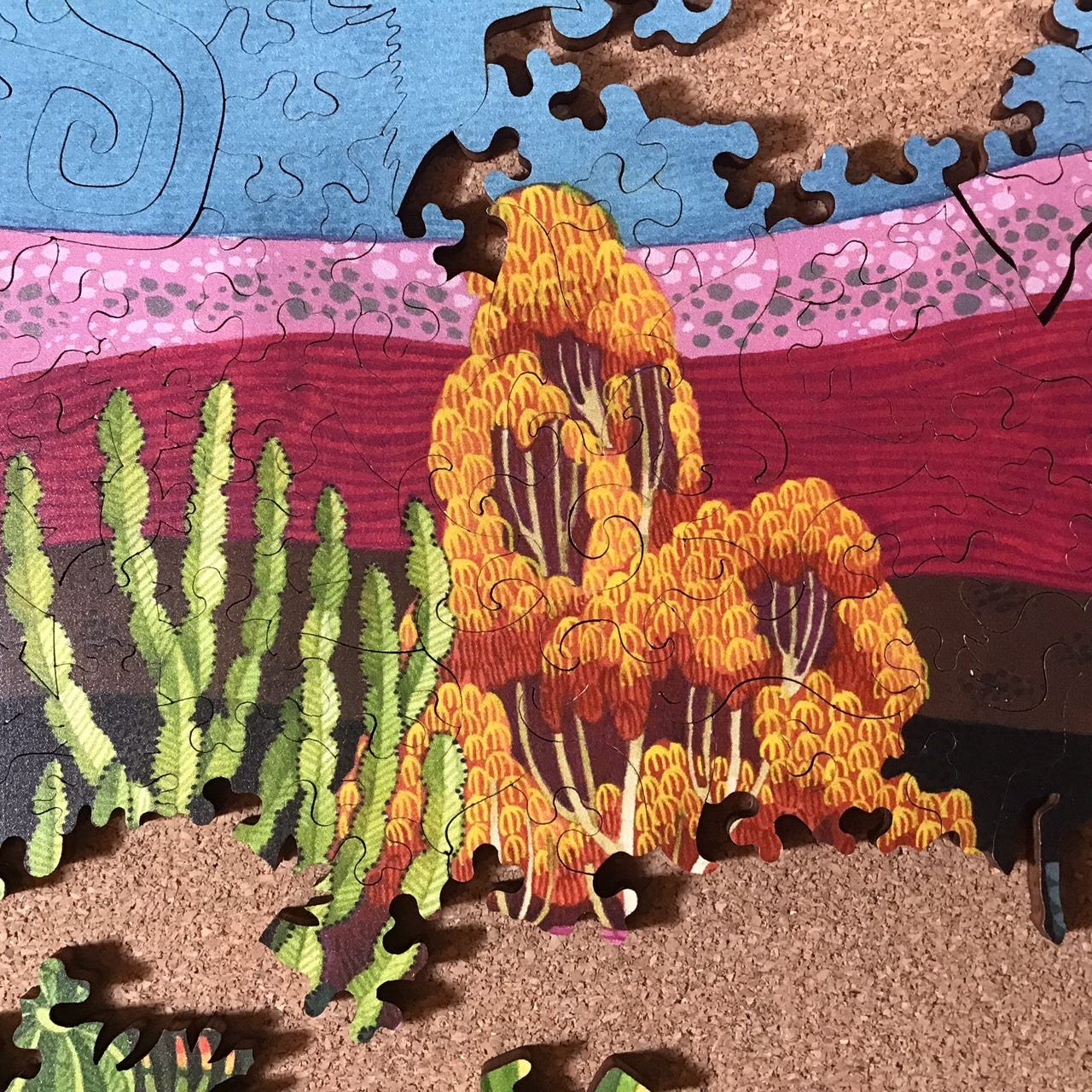
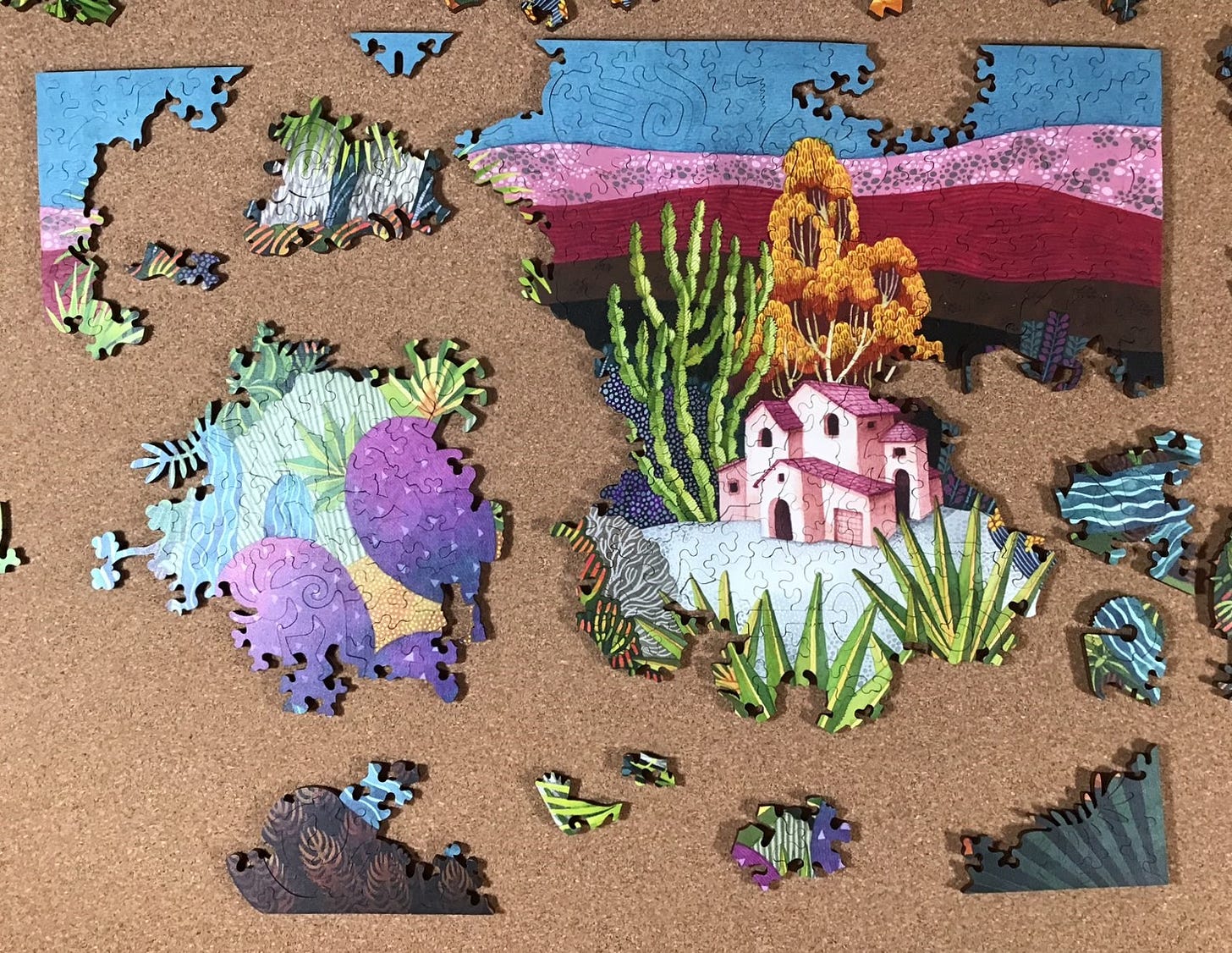
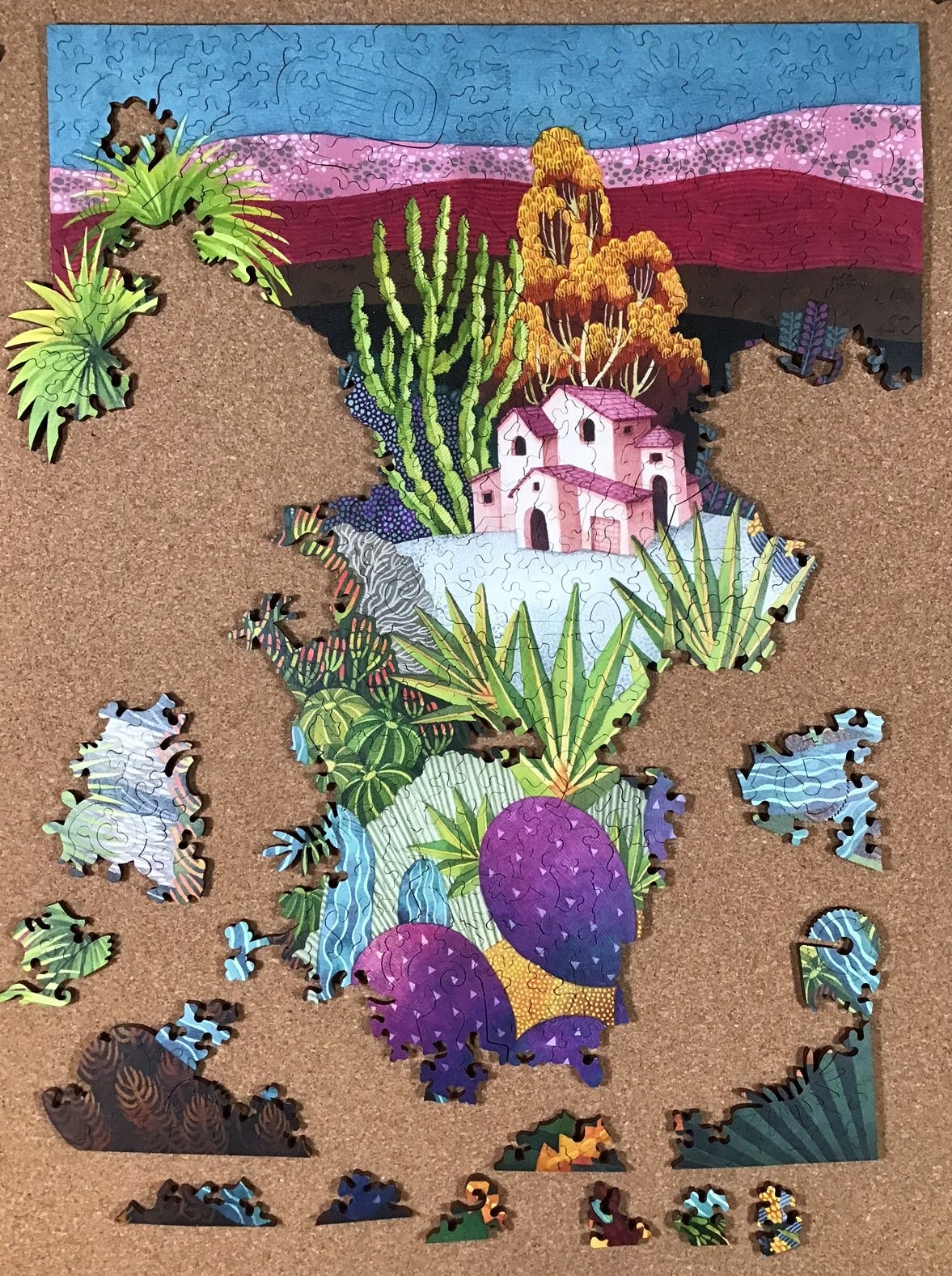
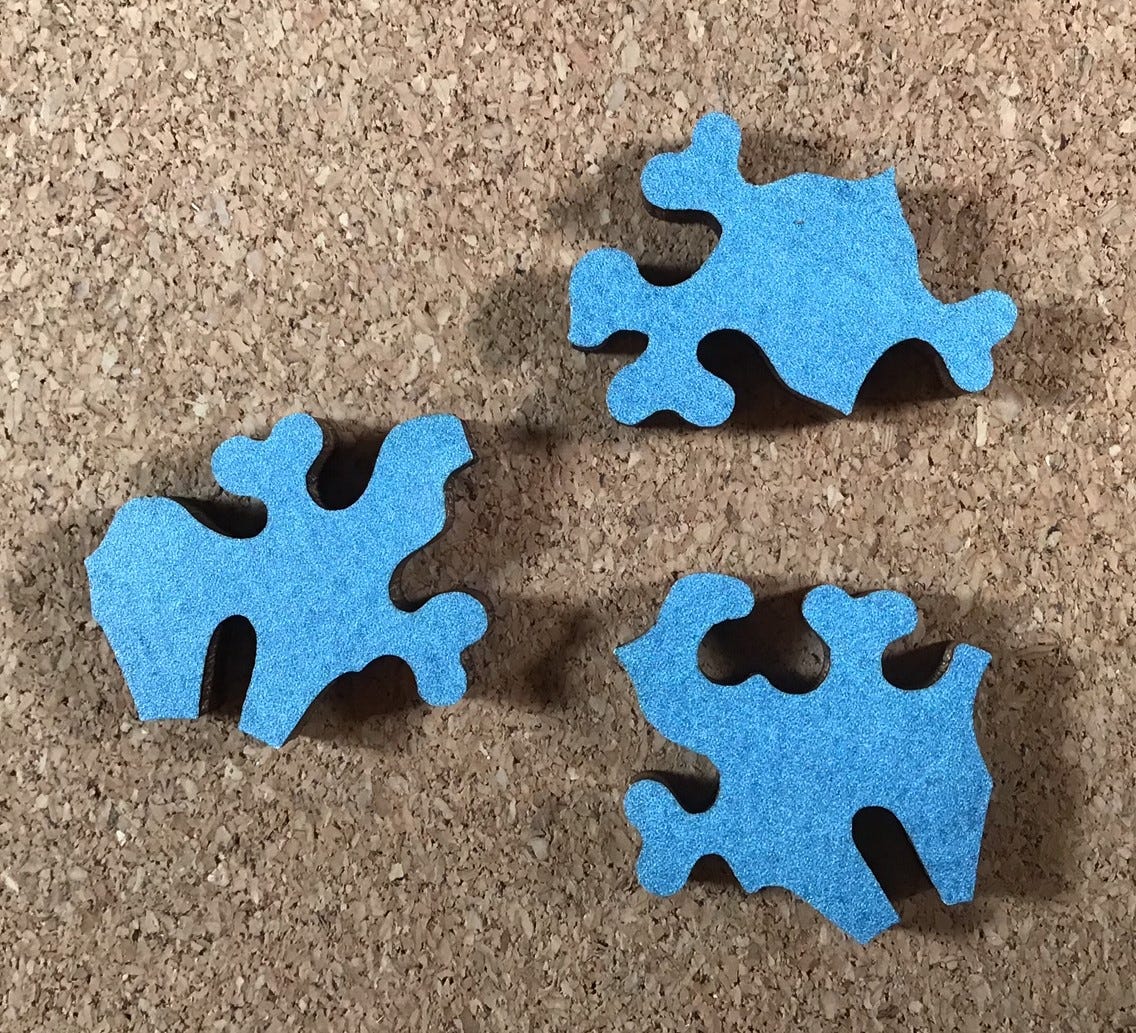


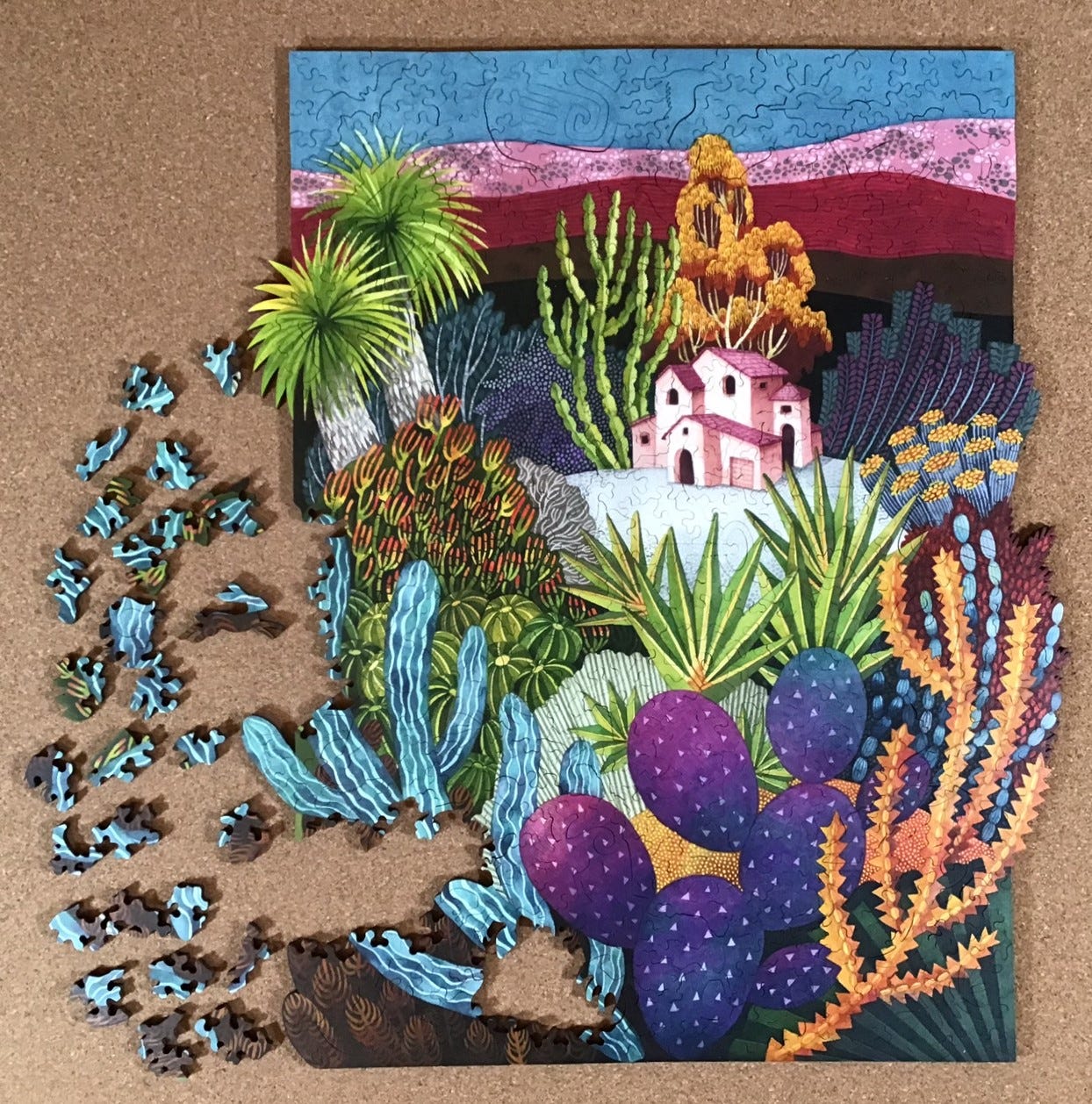


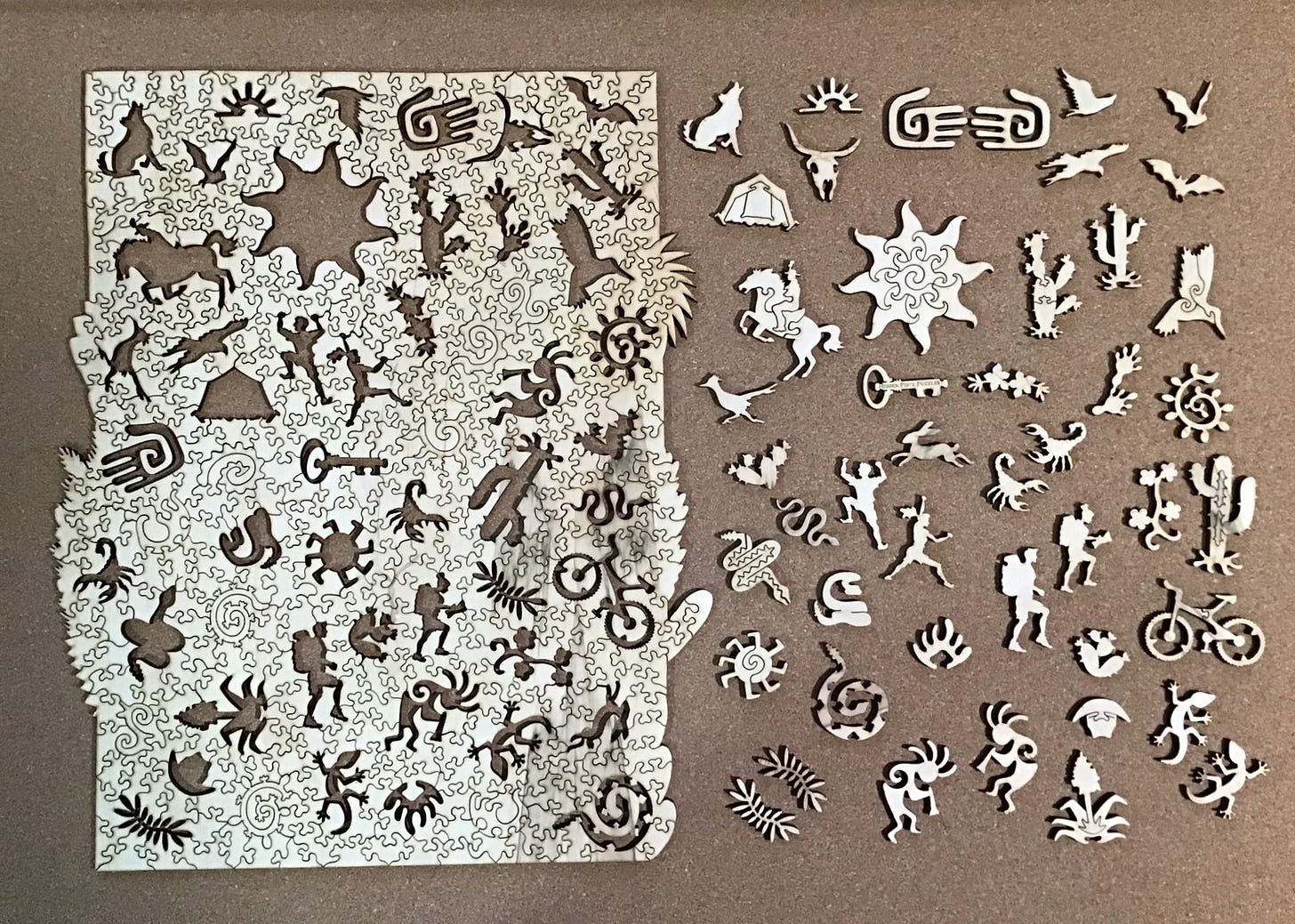
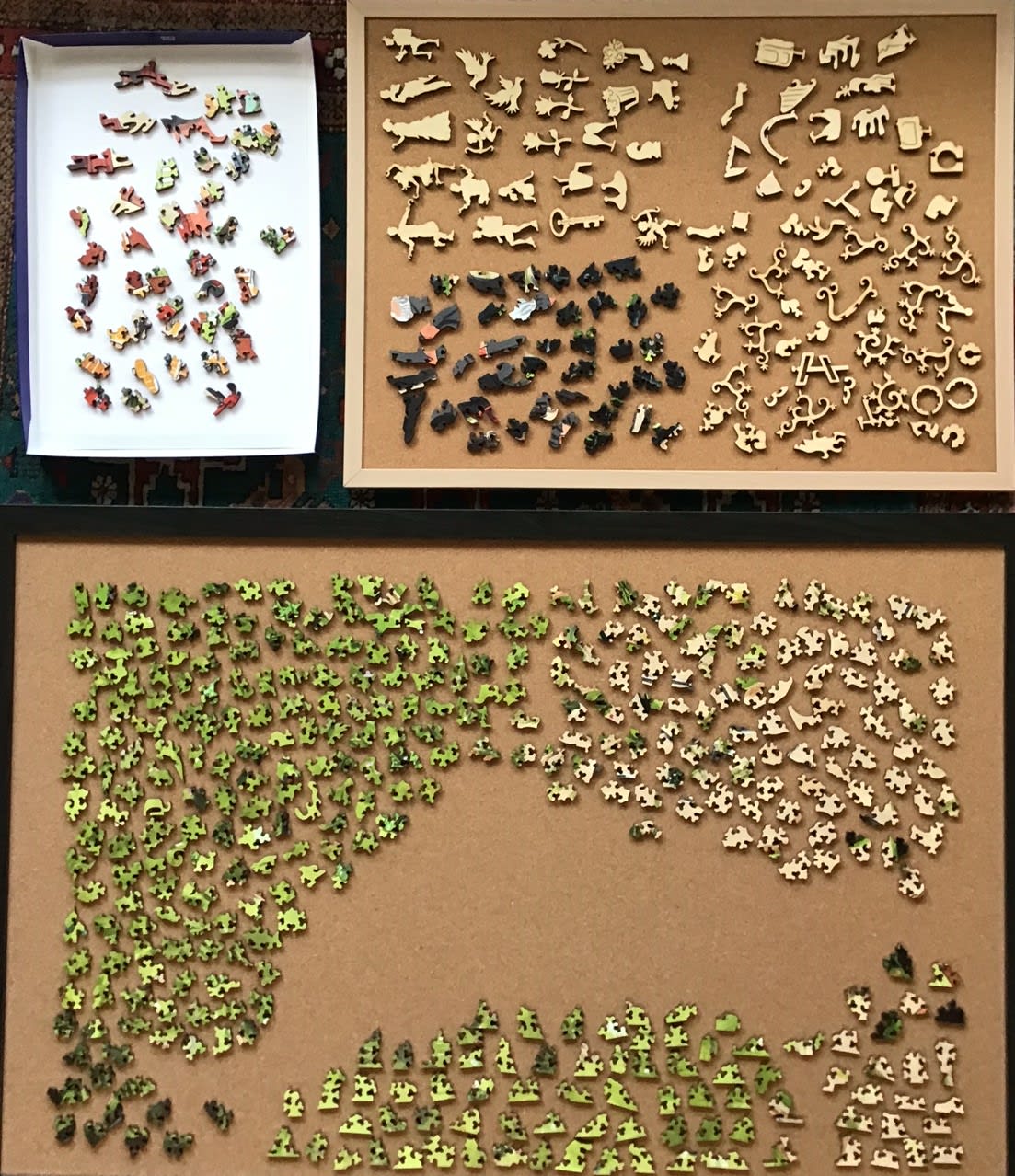
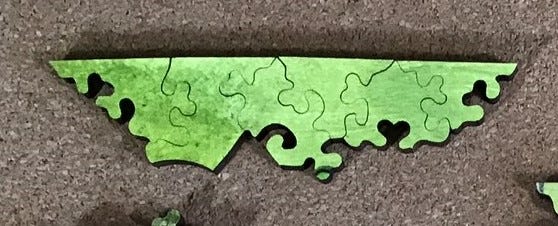
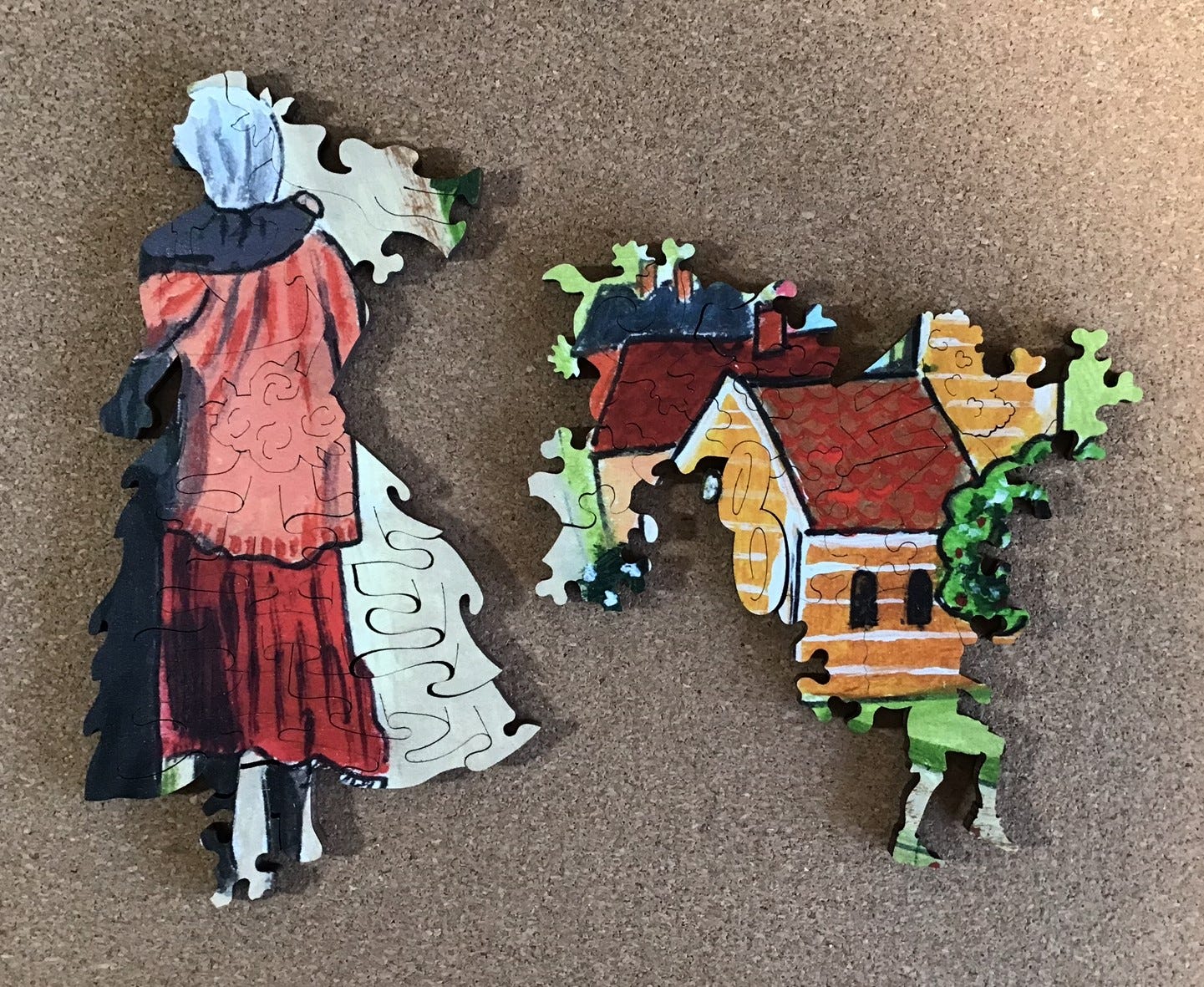
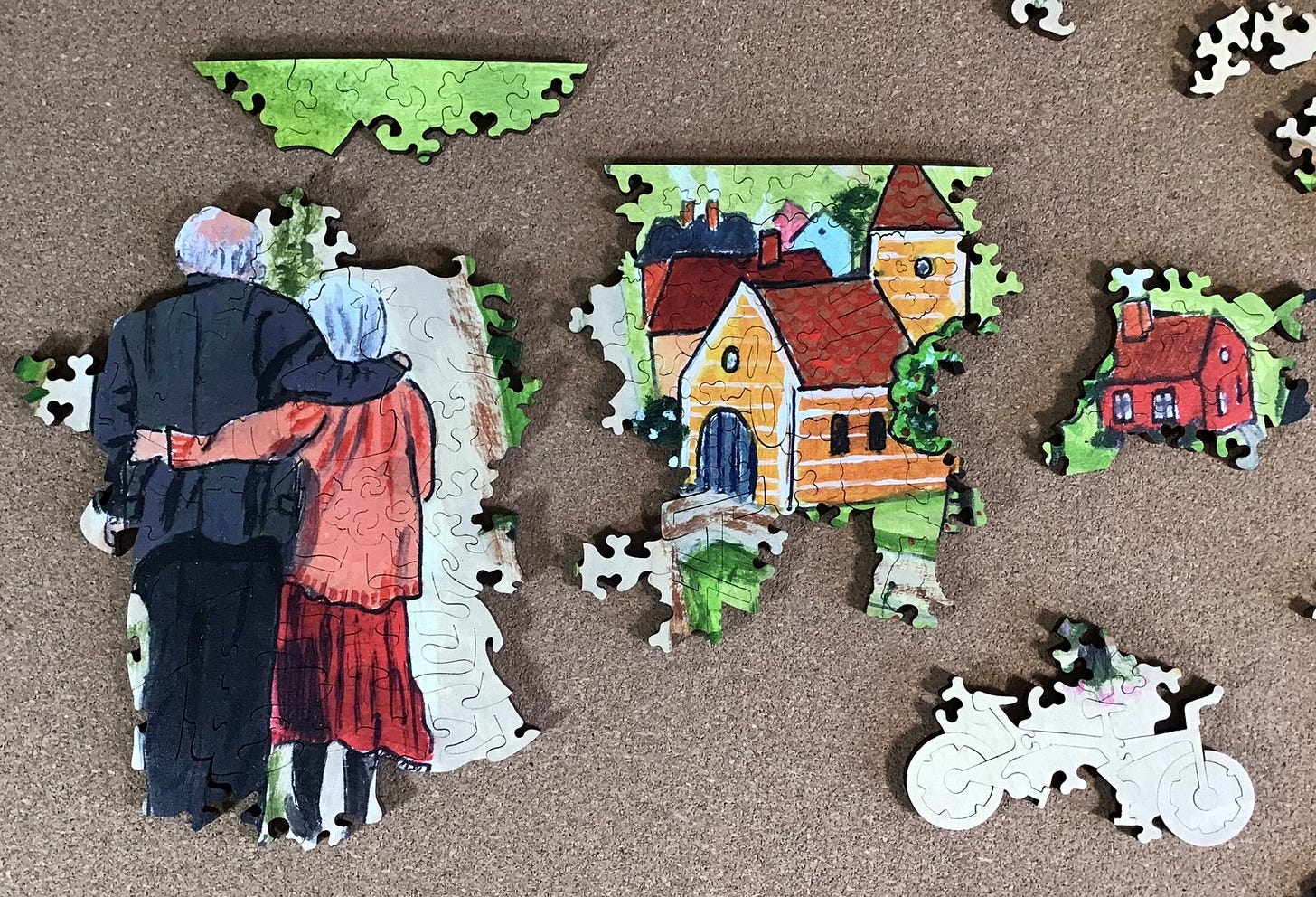
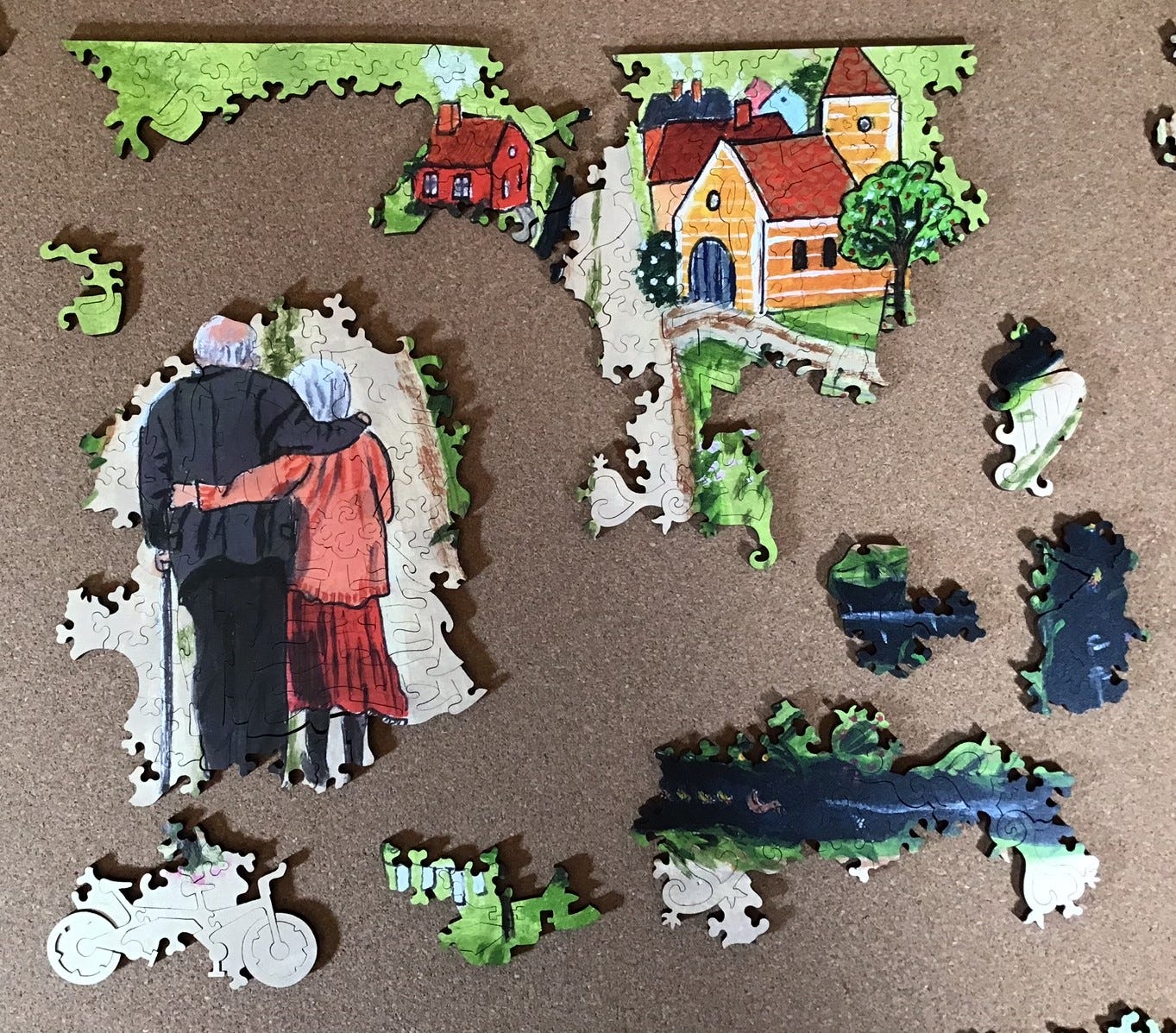
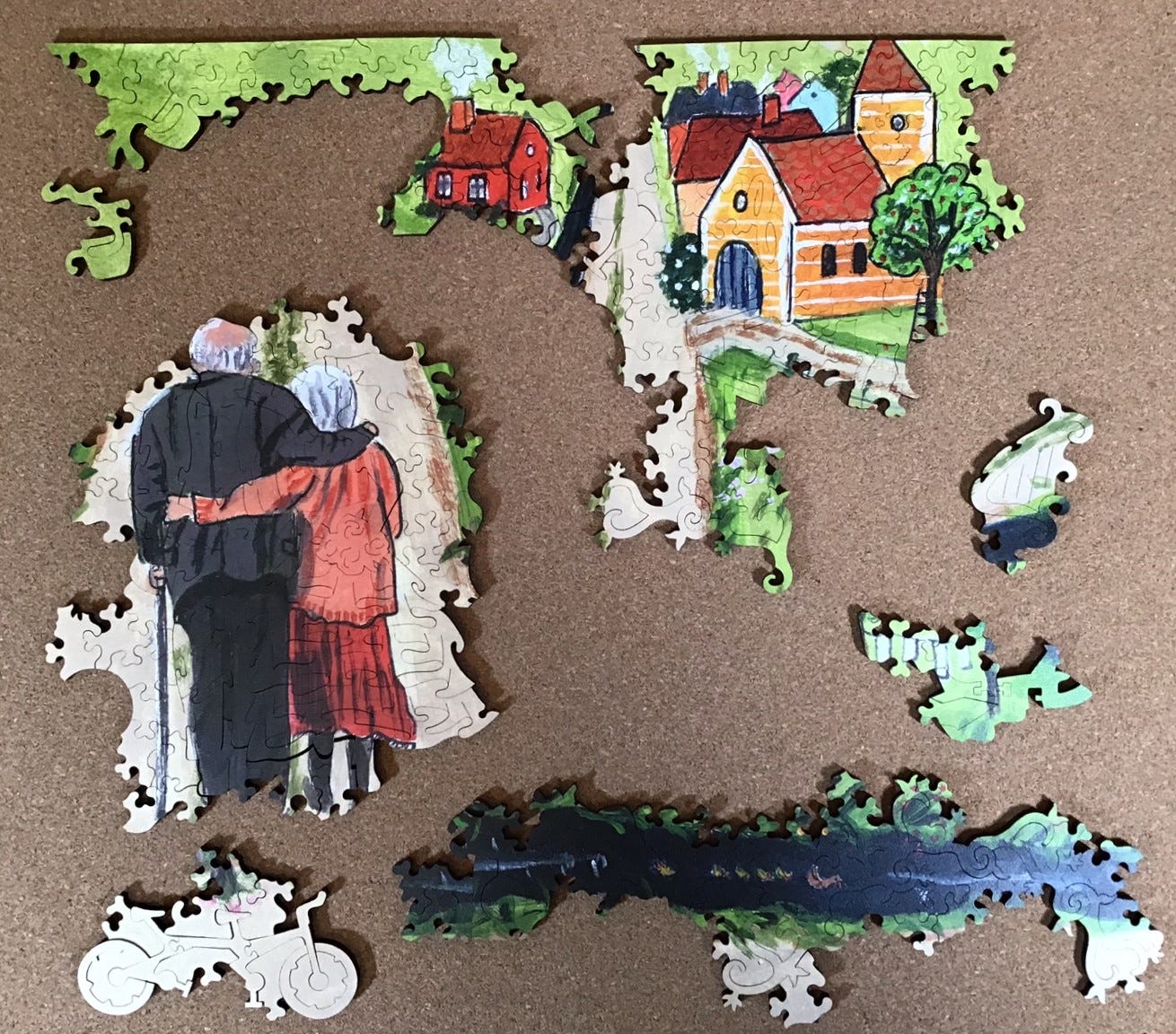



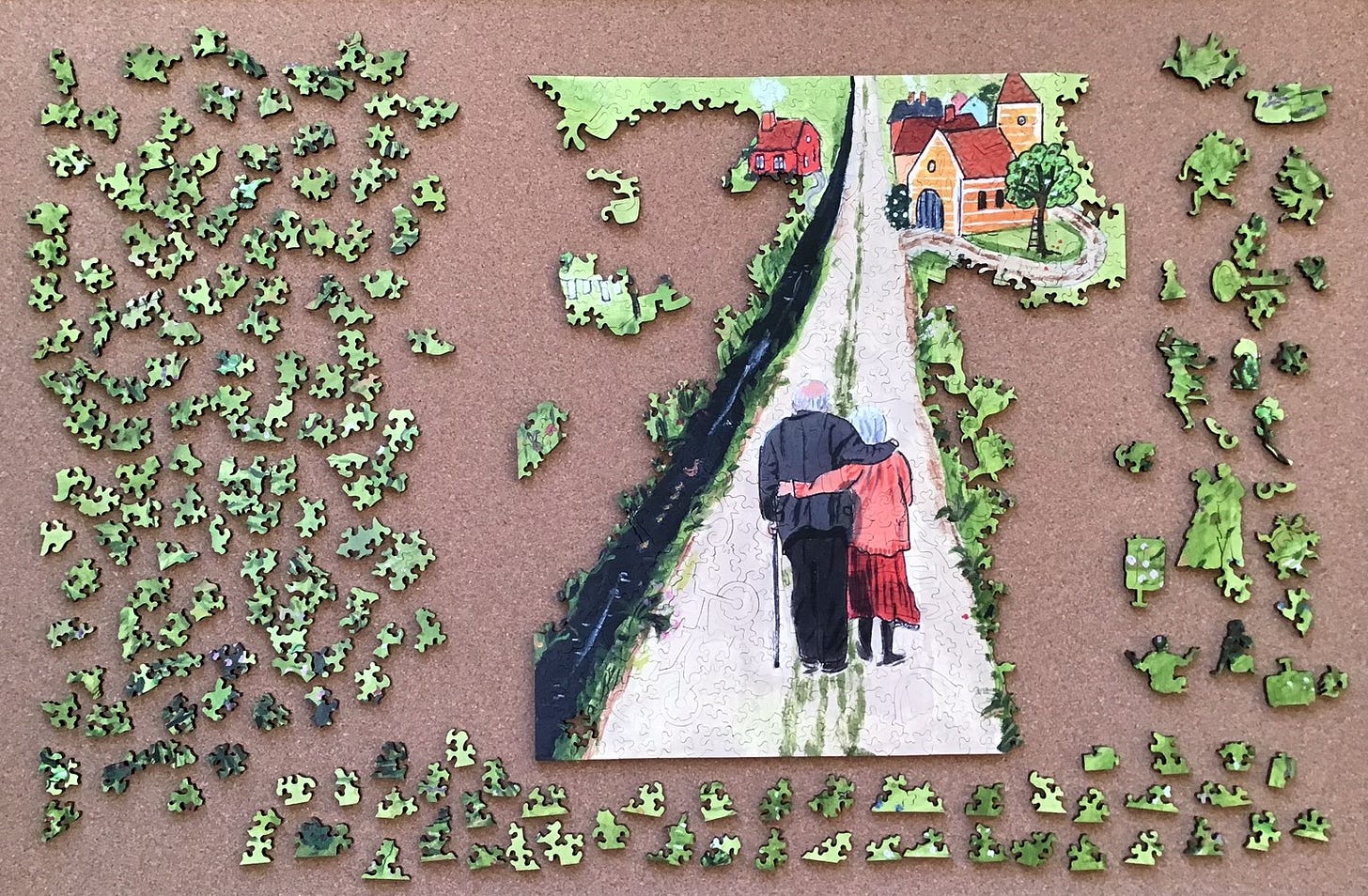
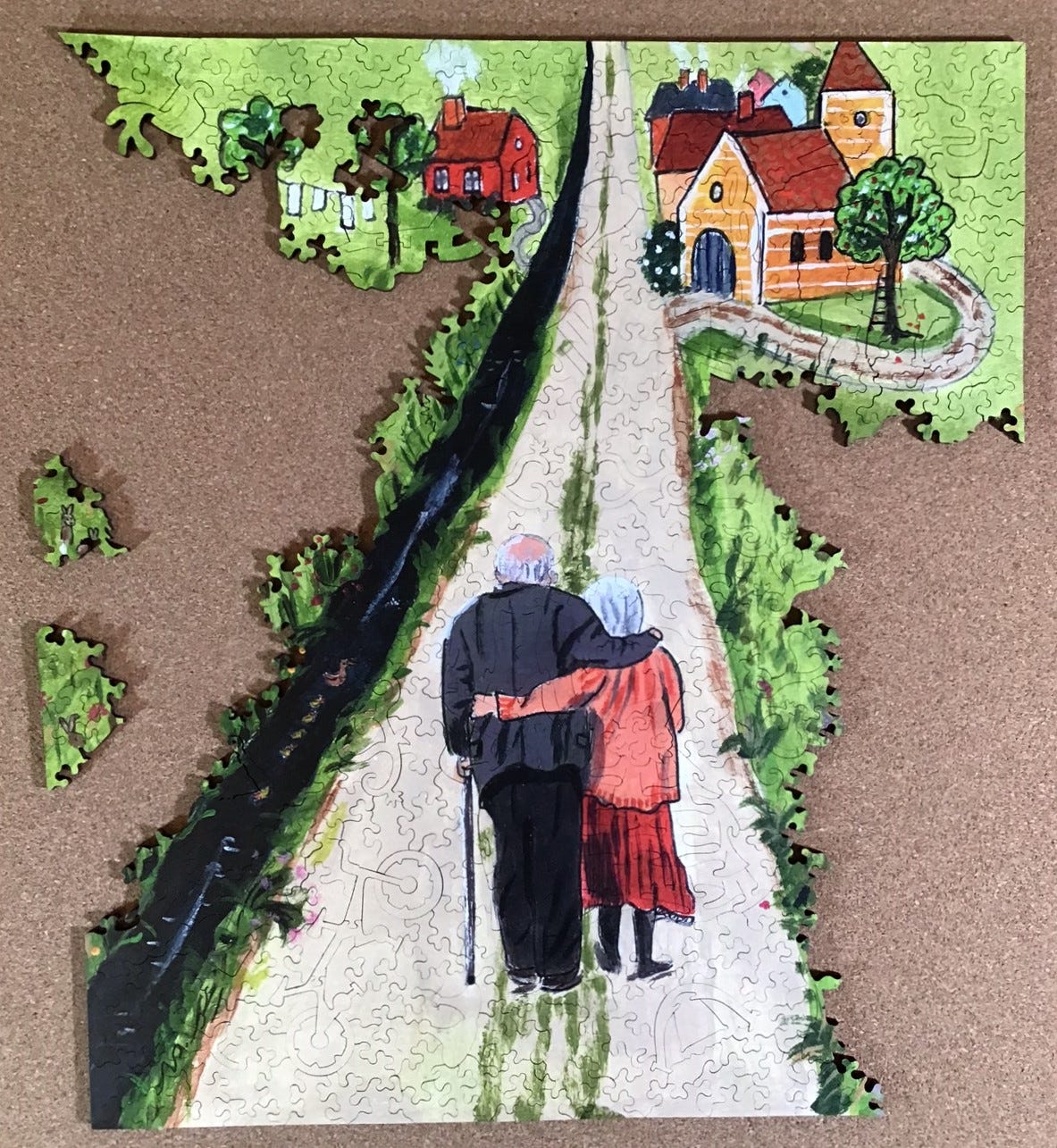
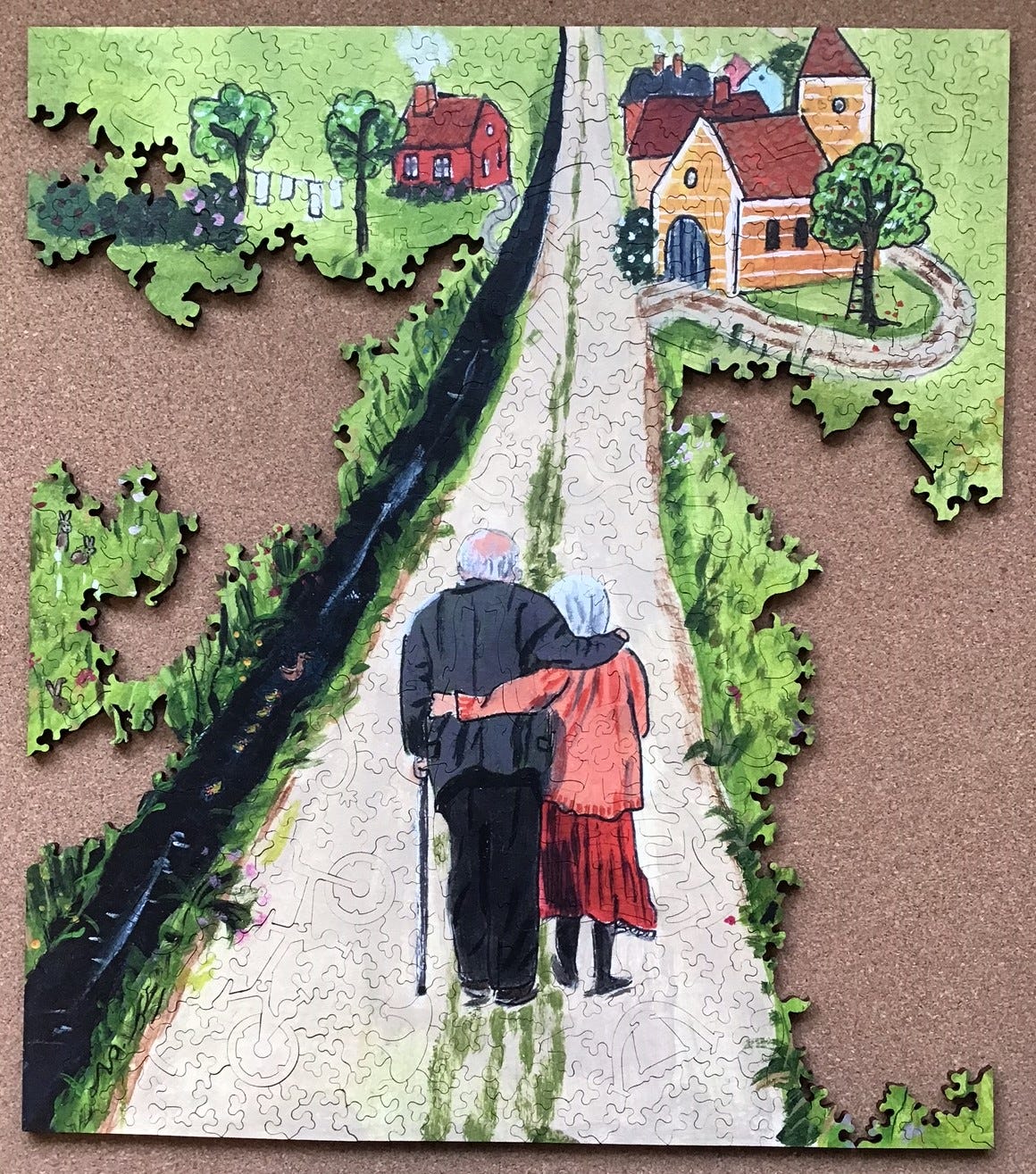
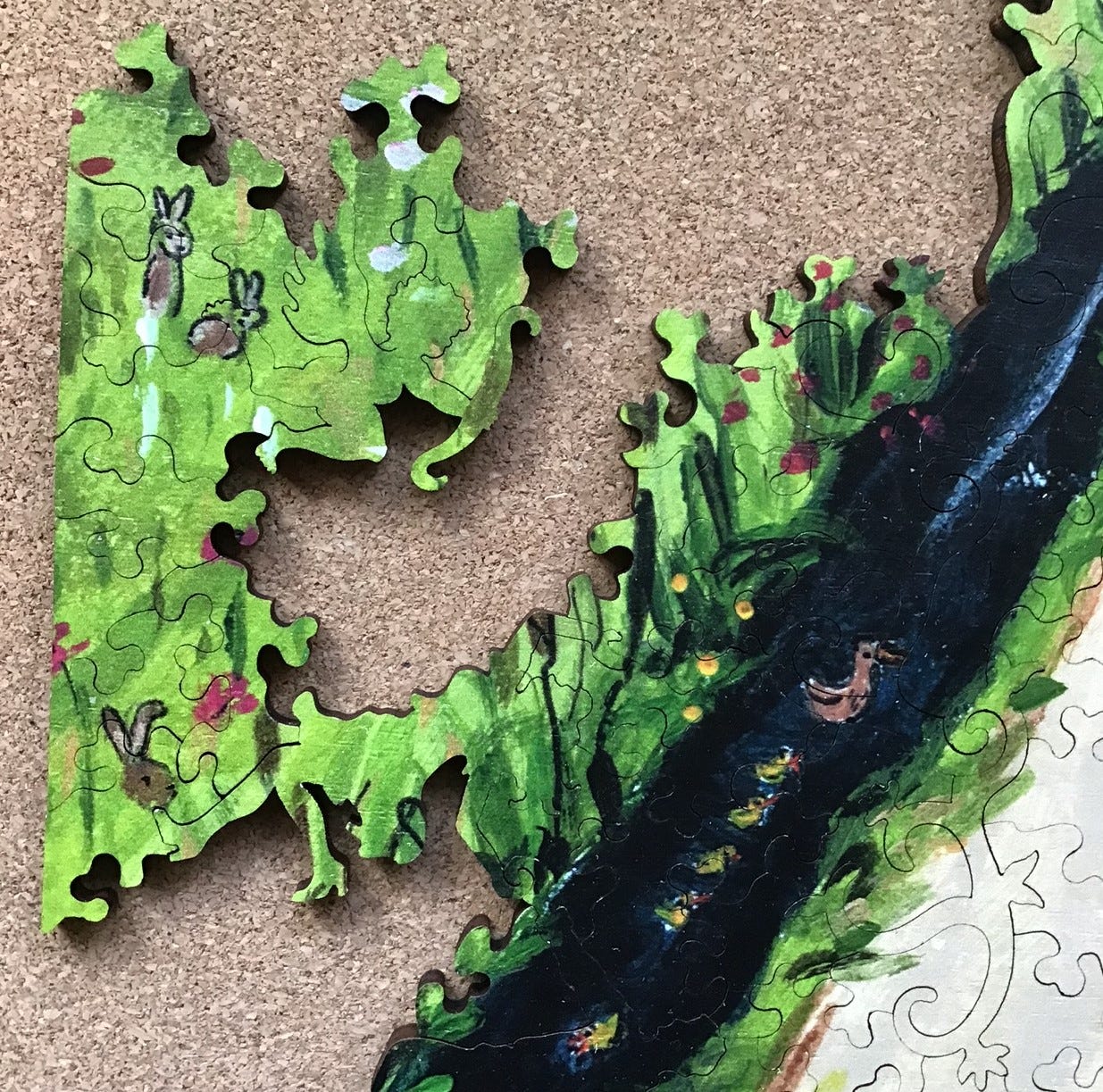
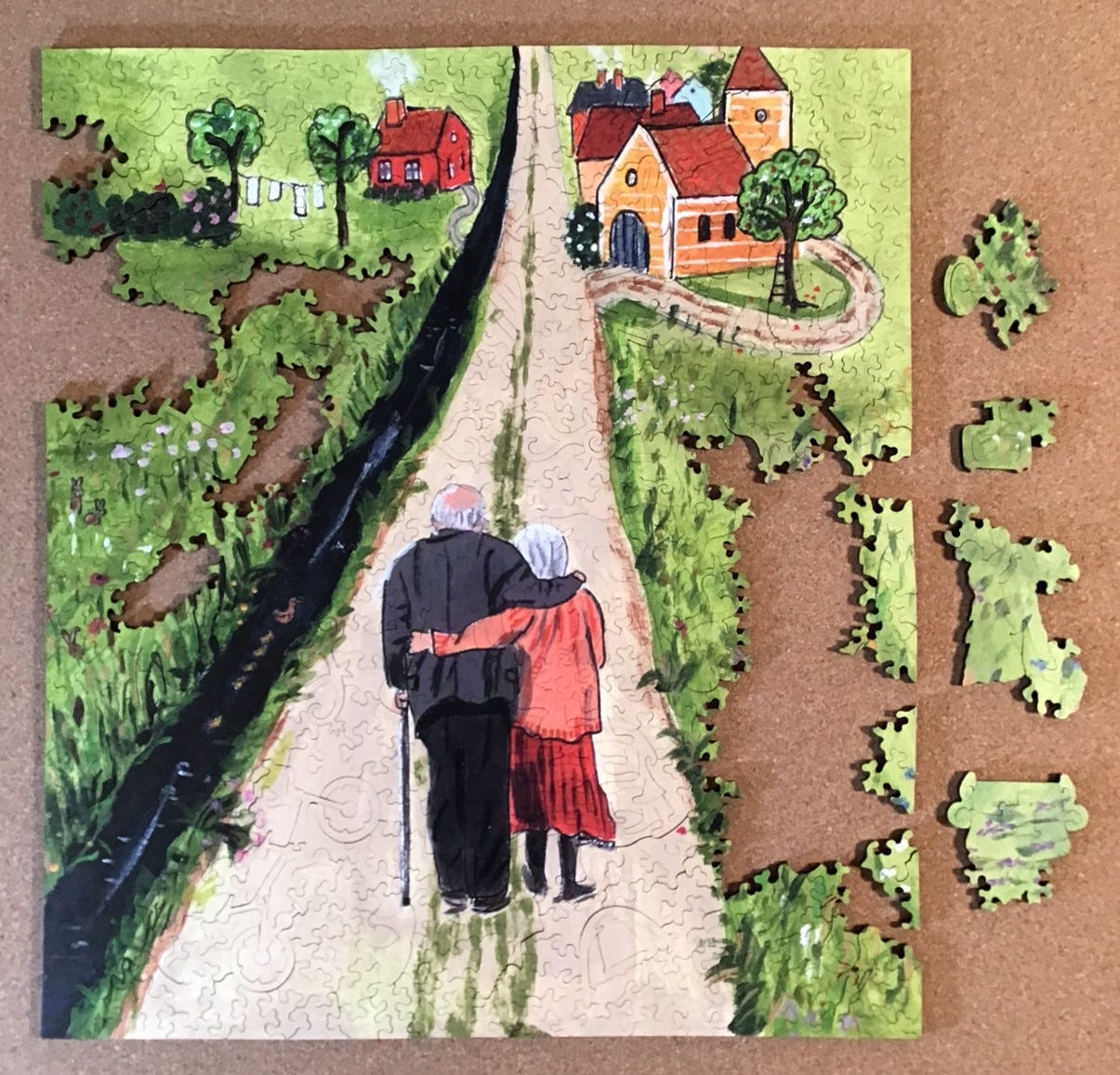
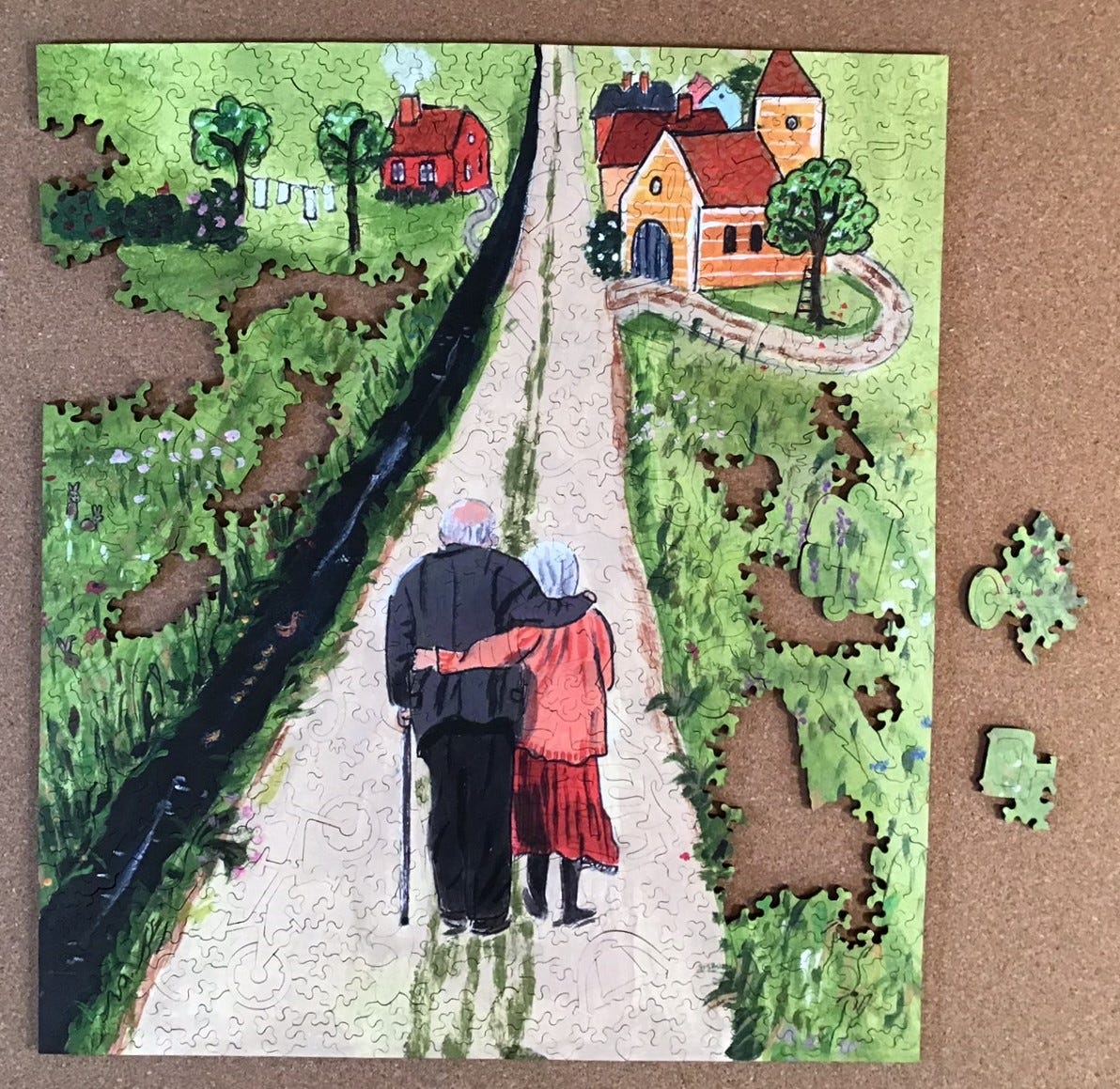
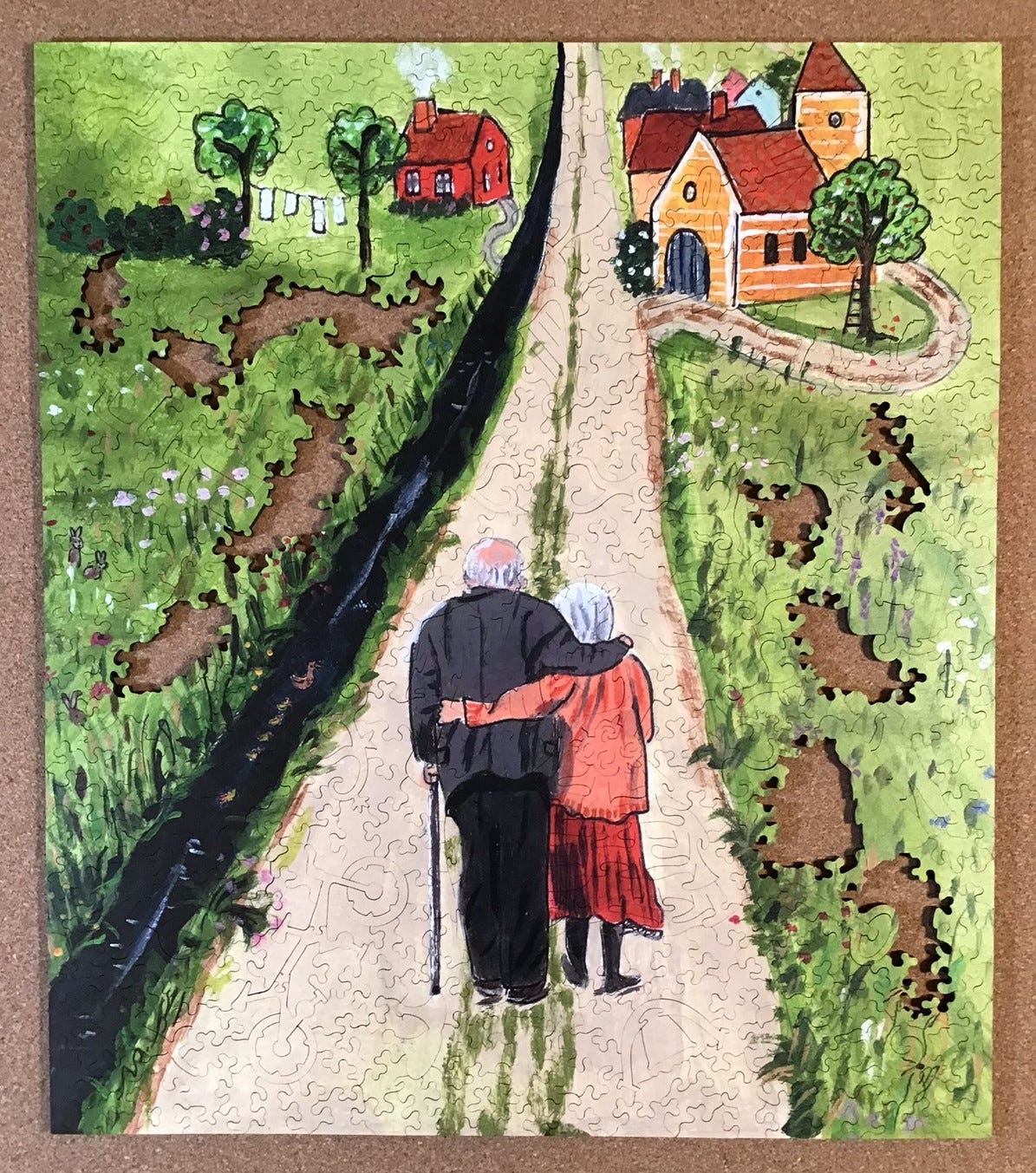
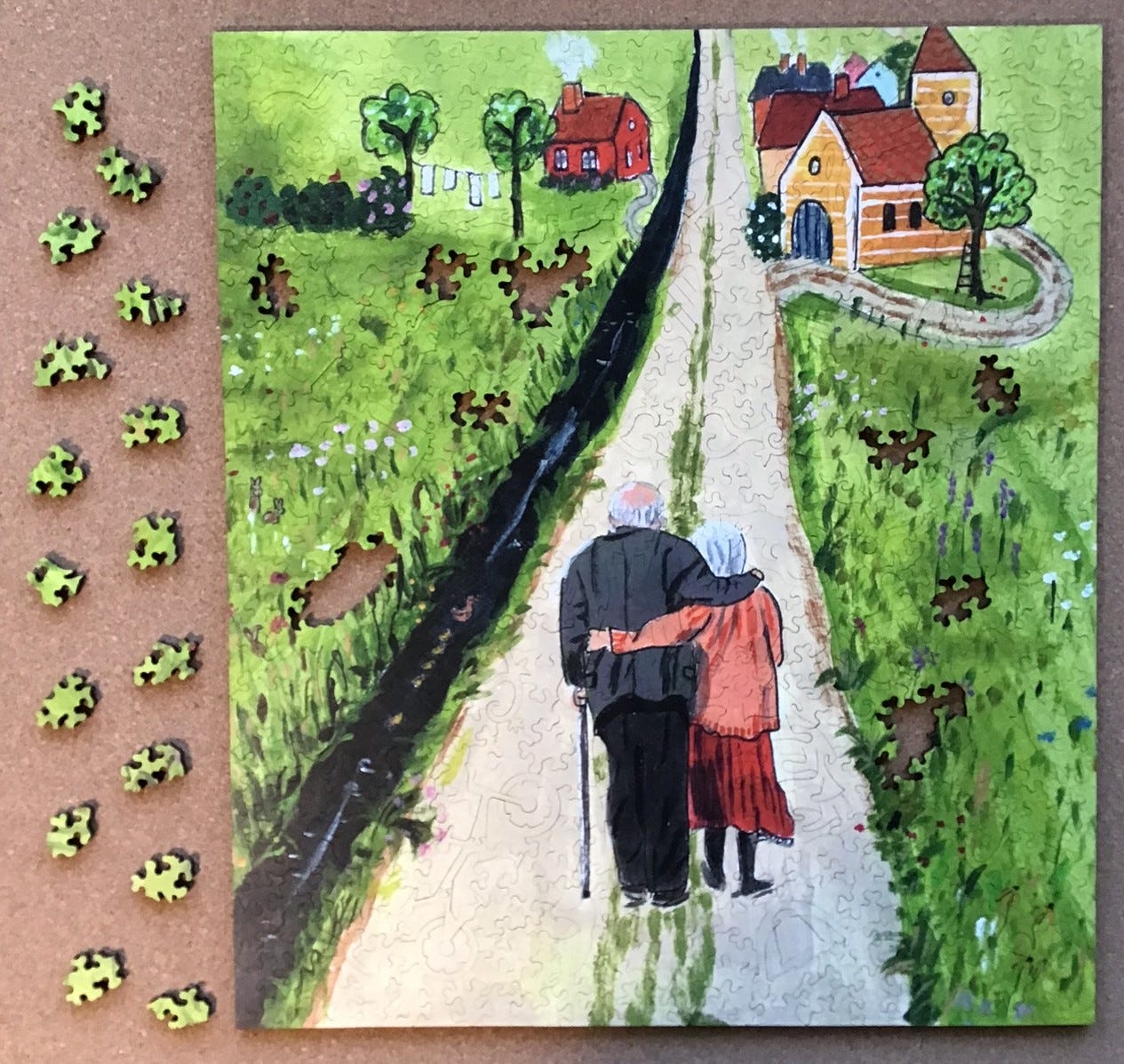
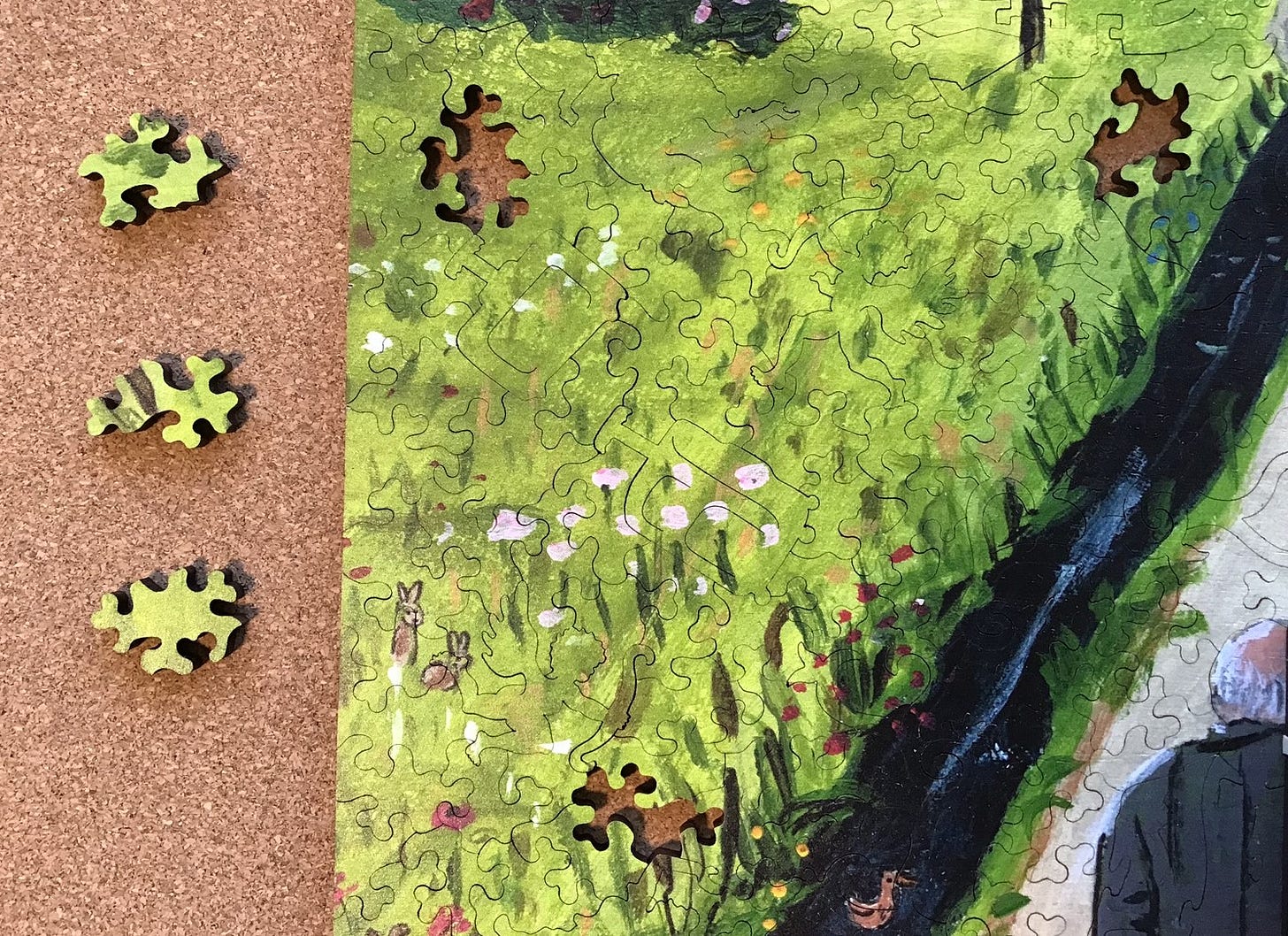


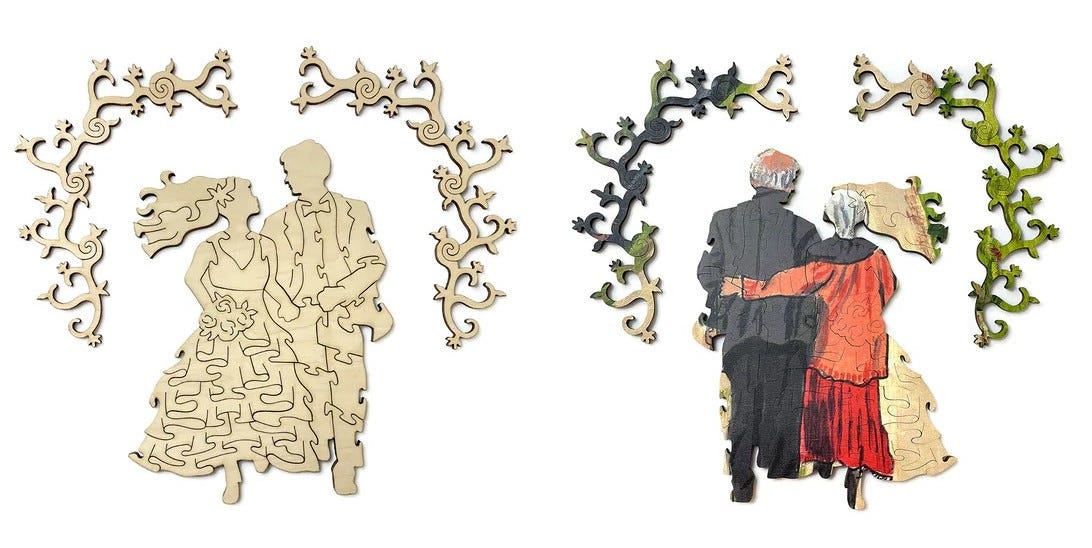
Okay, Bill, today's posting seems to me llke a departure in a different direction for you. You seem to have put together a more journalistic report than the hobbyist-type reports you've posted before. I'm hoping you will do more of both types. You have me liking "Grow Old Together" more now that I've had more explanation about its particular plan and qualities. Last posting, I was enamored with "Home in the Desert 1." By the way, the first mention of that puzzle today has it entitled "Home on the Desert 1." You might want to correct that. I was very pleased to see three images by Picasso today, all three of which I admire. Of Gwen van Knippenberg's work, I like best the picture of the woman cutting out gingerbread cookies. Back to Shachi Kale's work for a moment, I want to say that I really like how the hidden image of the two oldsters shows them as a younger, loving couple. I know you have been contacting and communicating directly with artists and puzzle producers, and your growth as an interviewer, if I may call you that, reminds me that I had great fun about twenty years ago interviewing and writing up the stories of gold panners on Vancouver Island. Cheers to you, Bill, and do carry on.